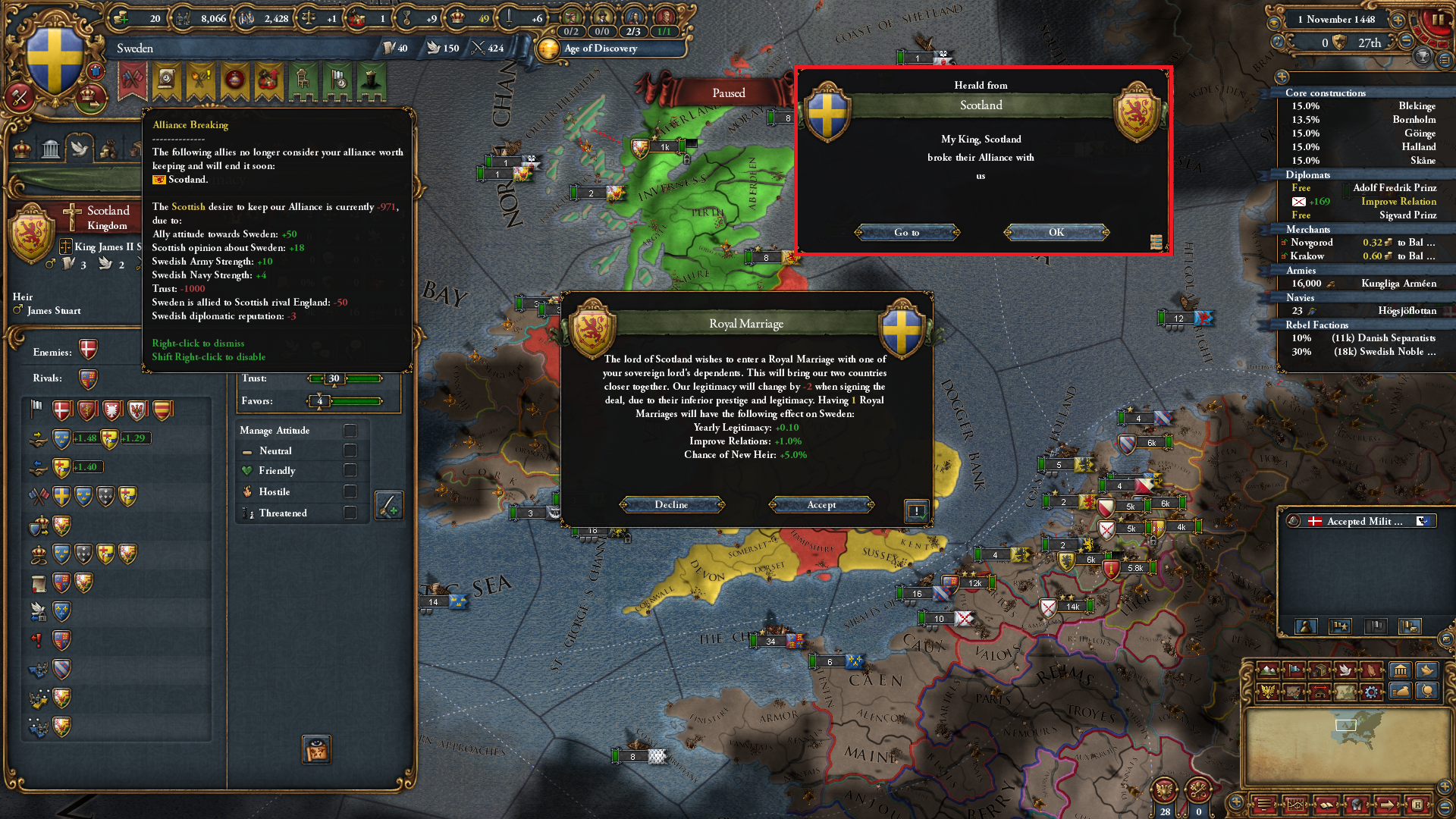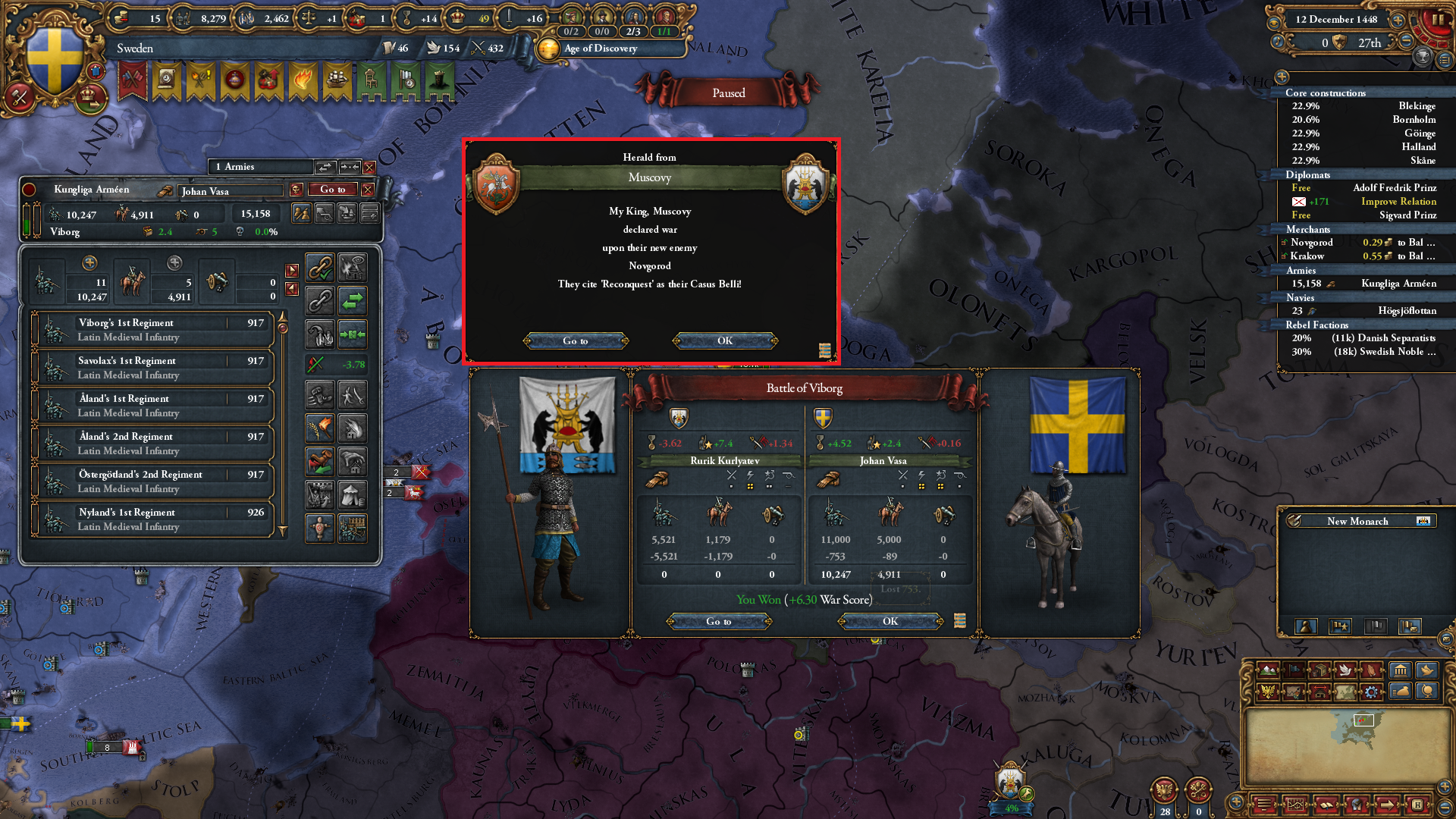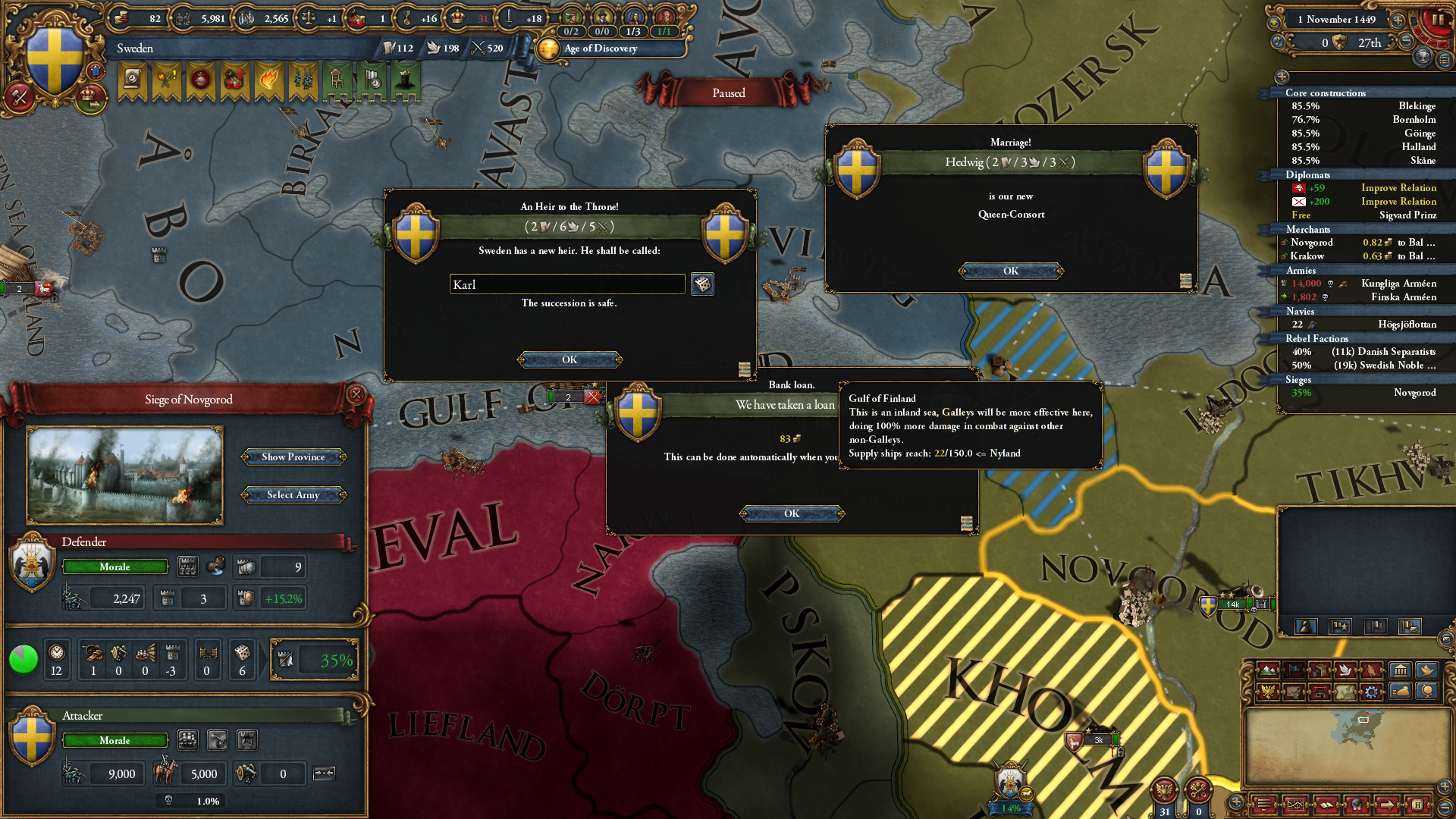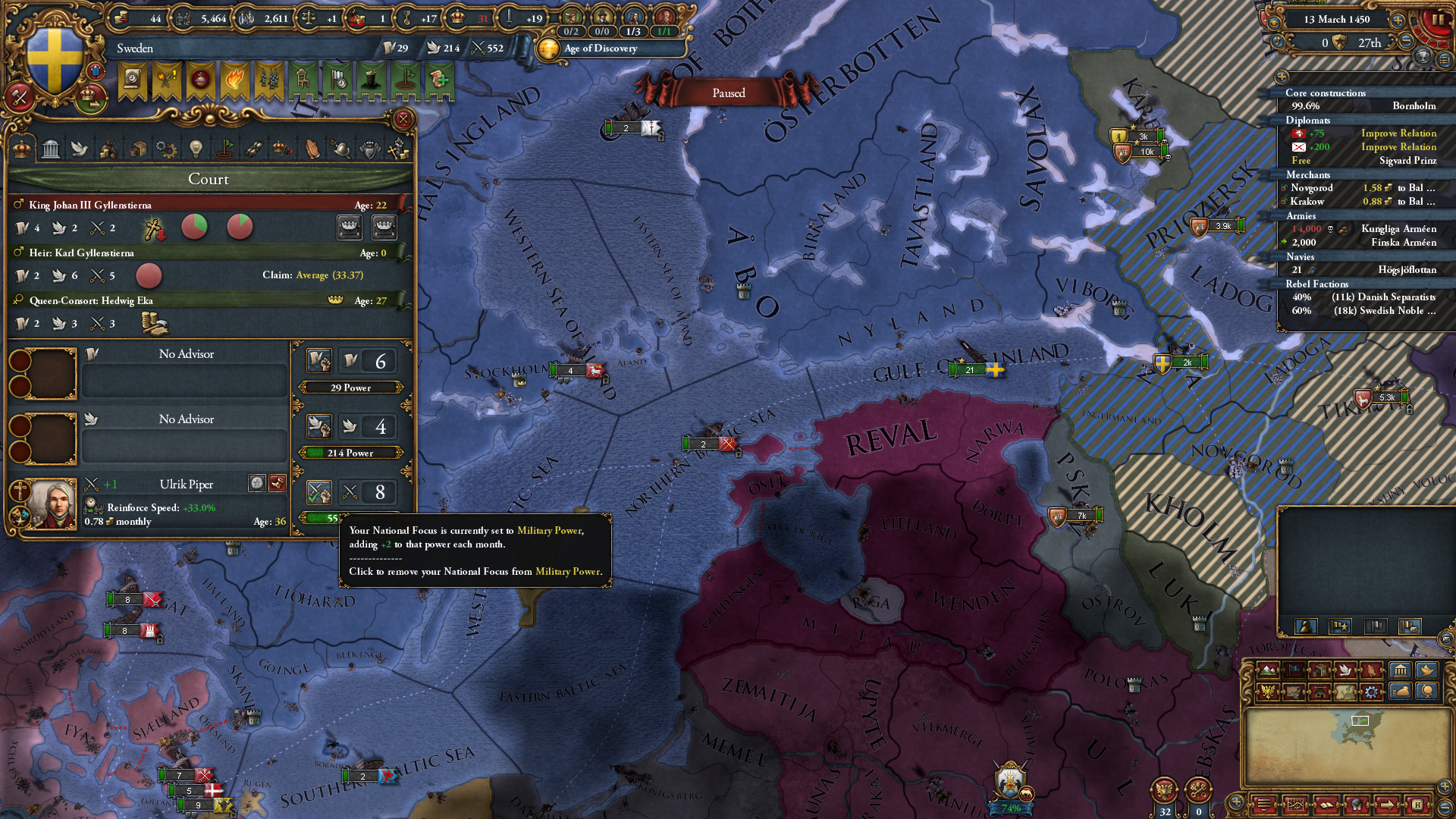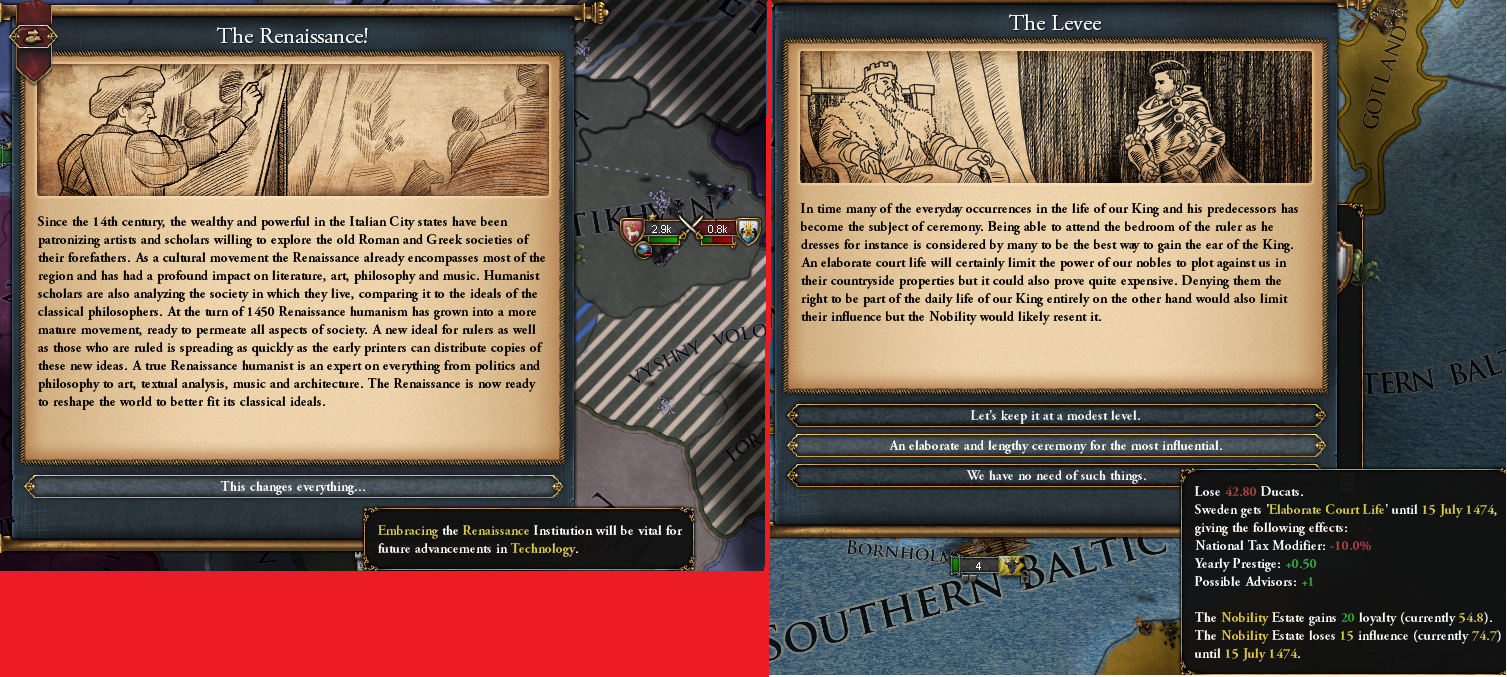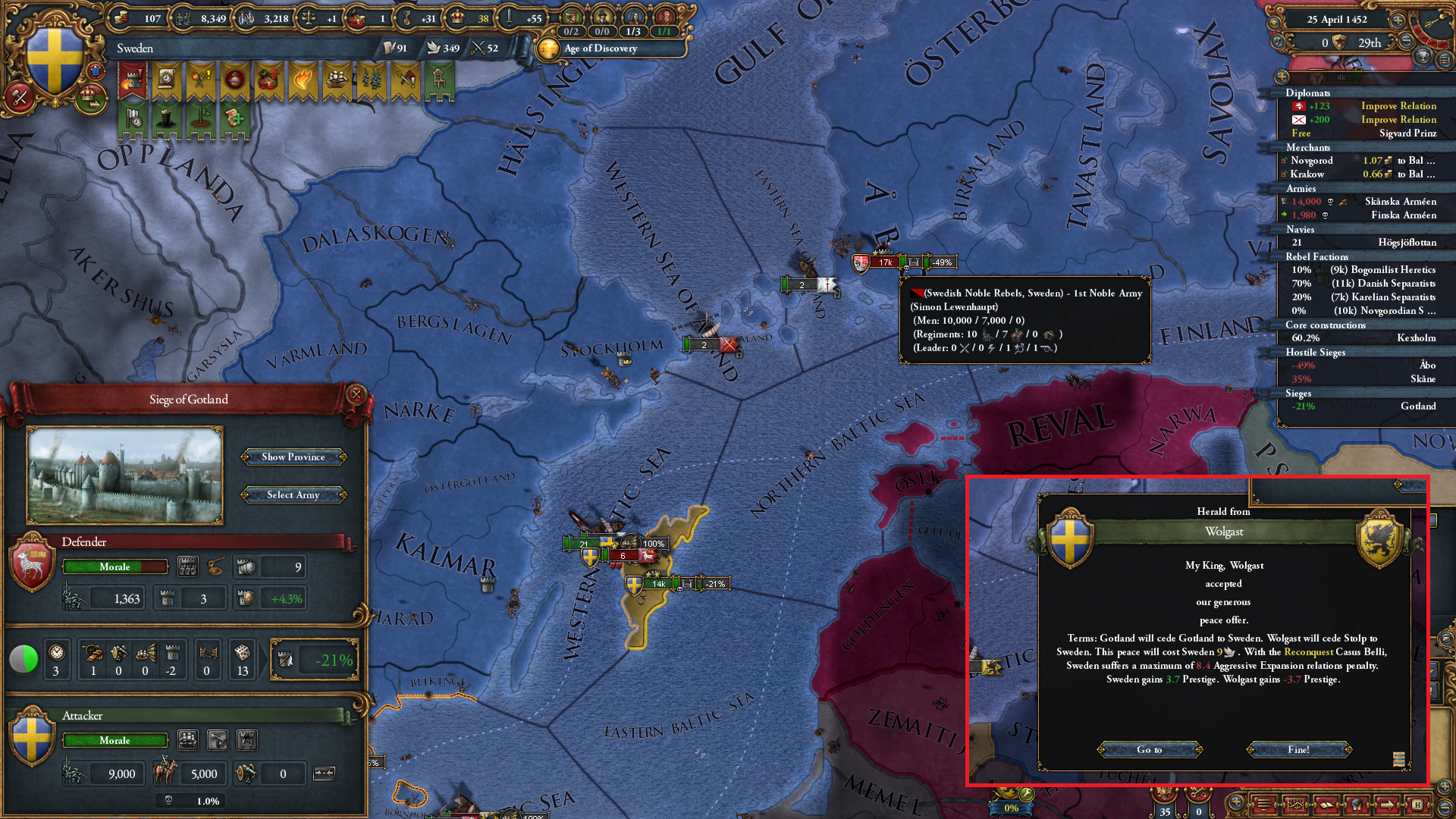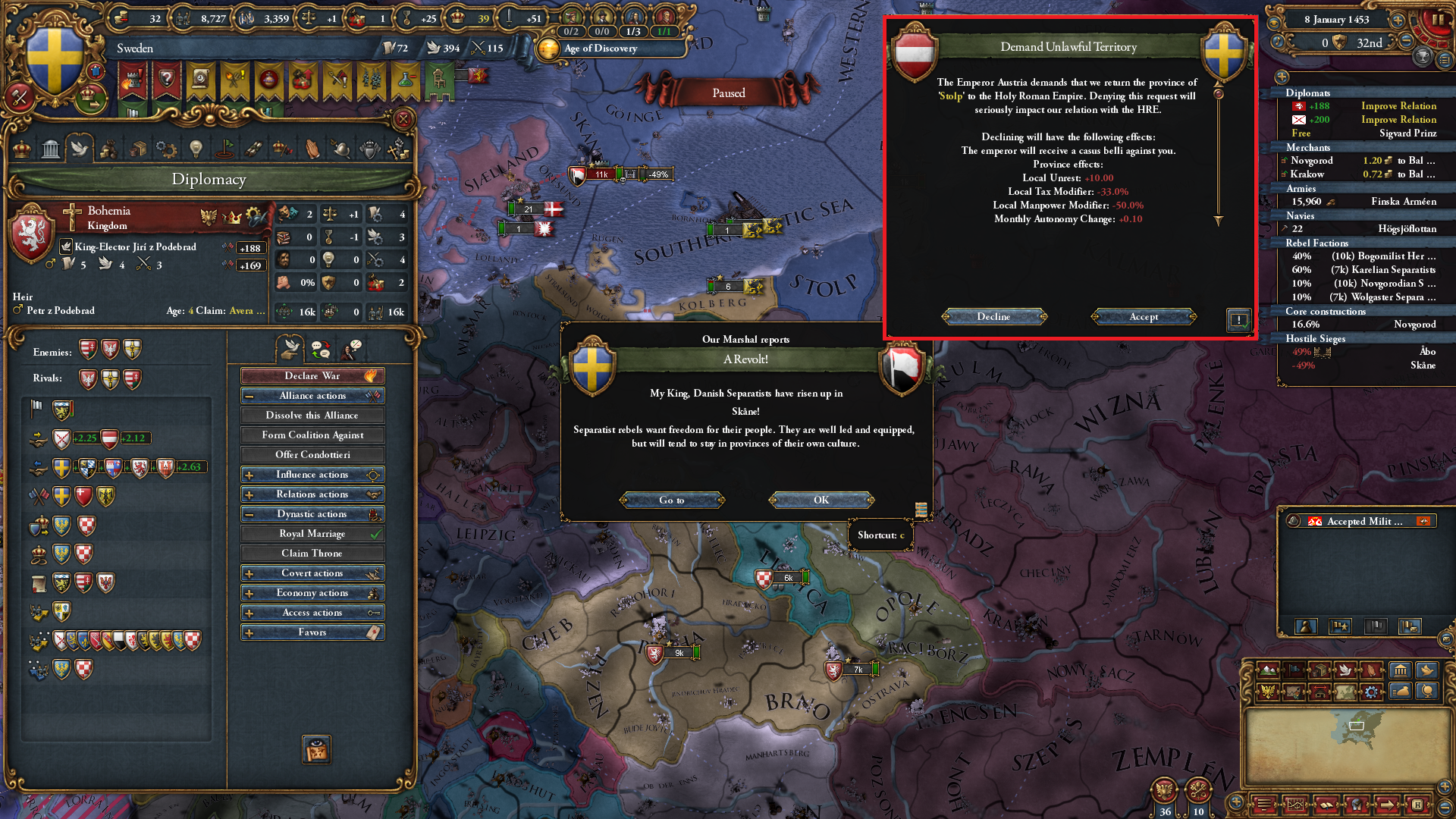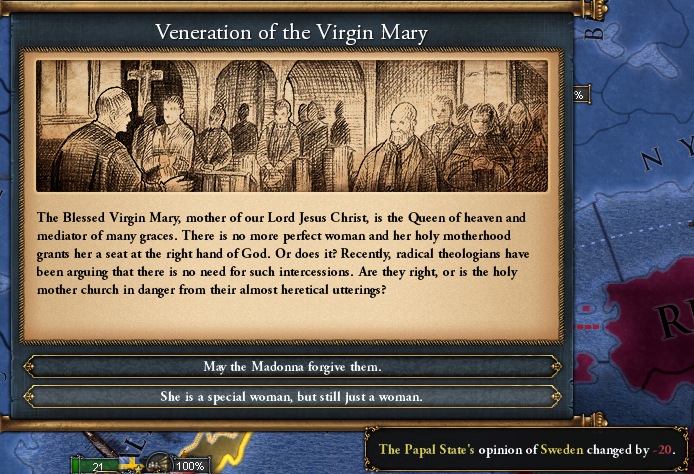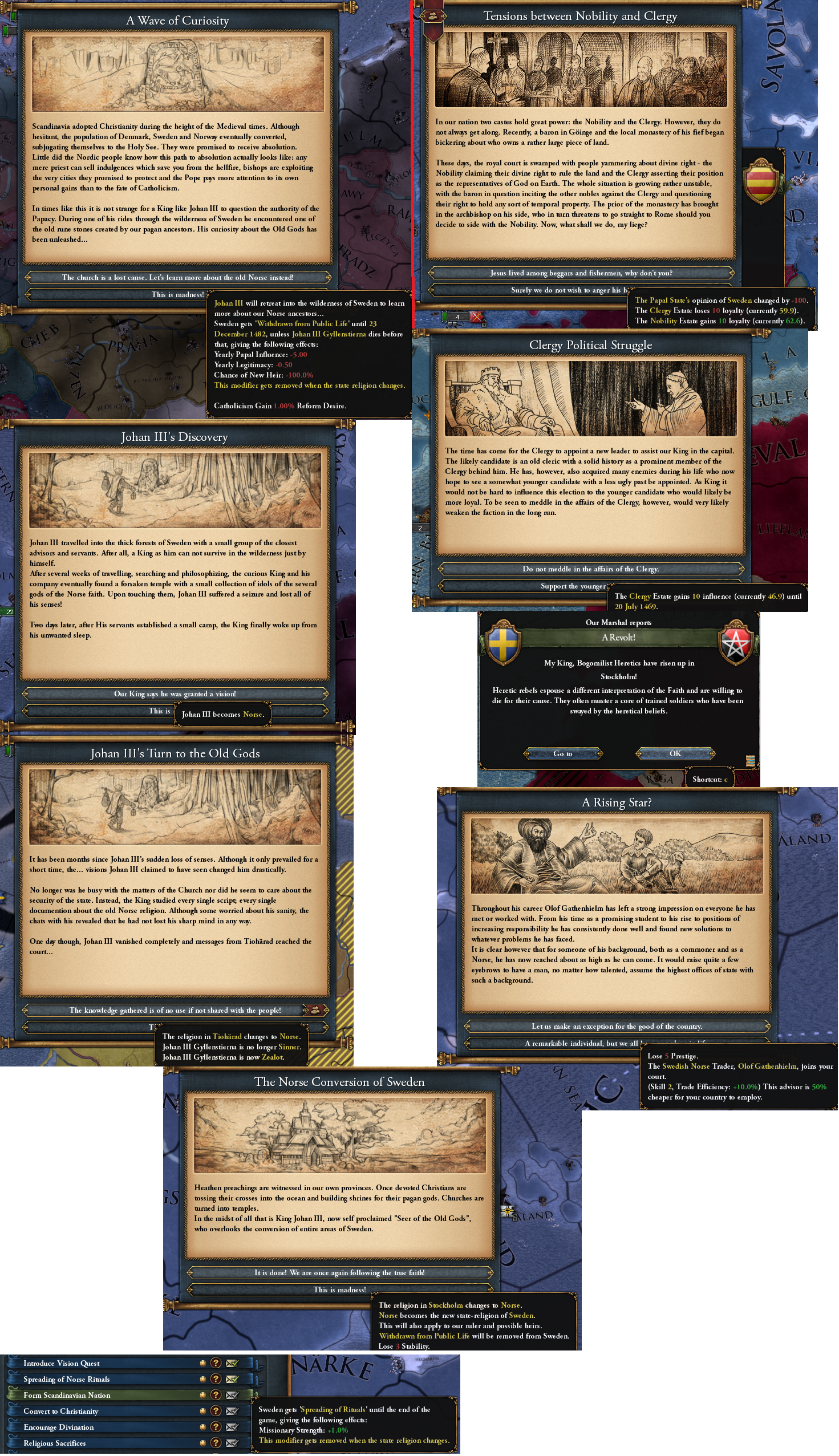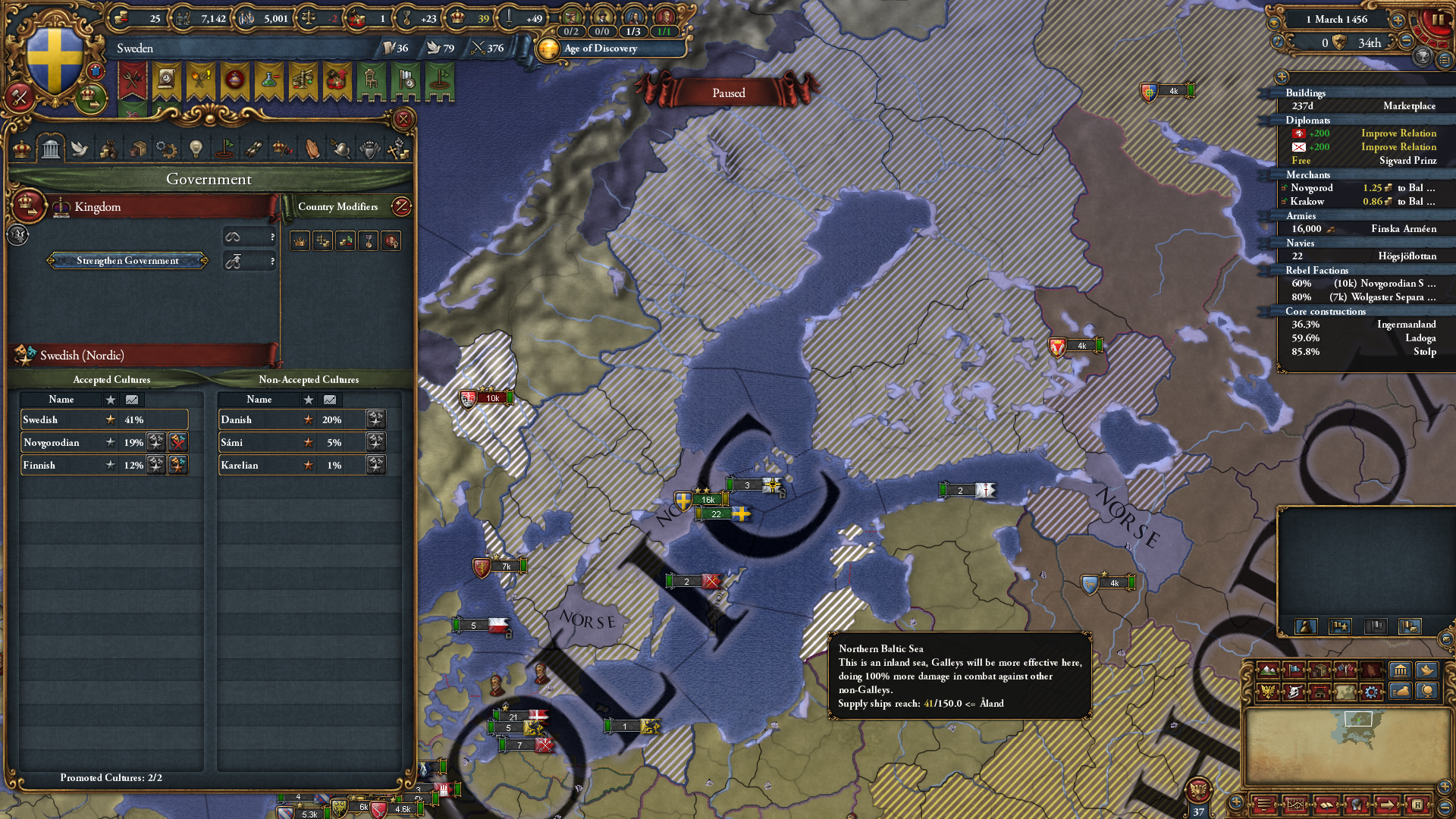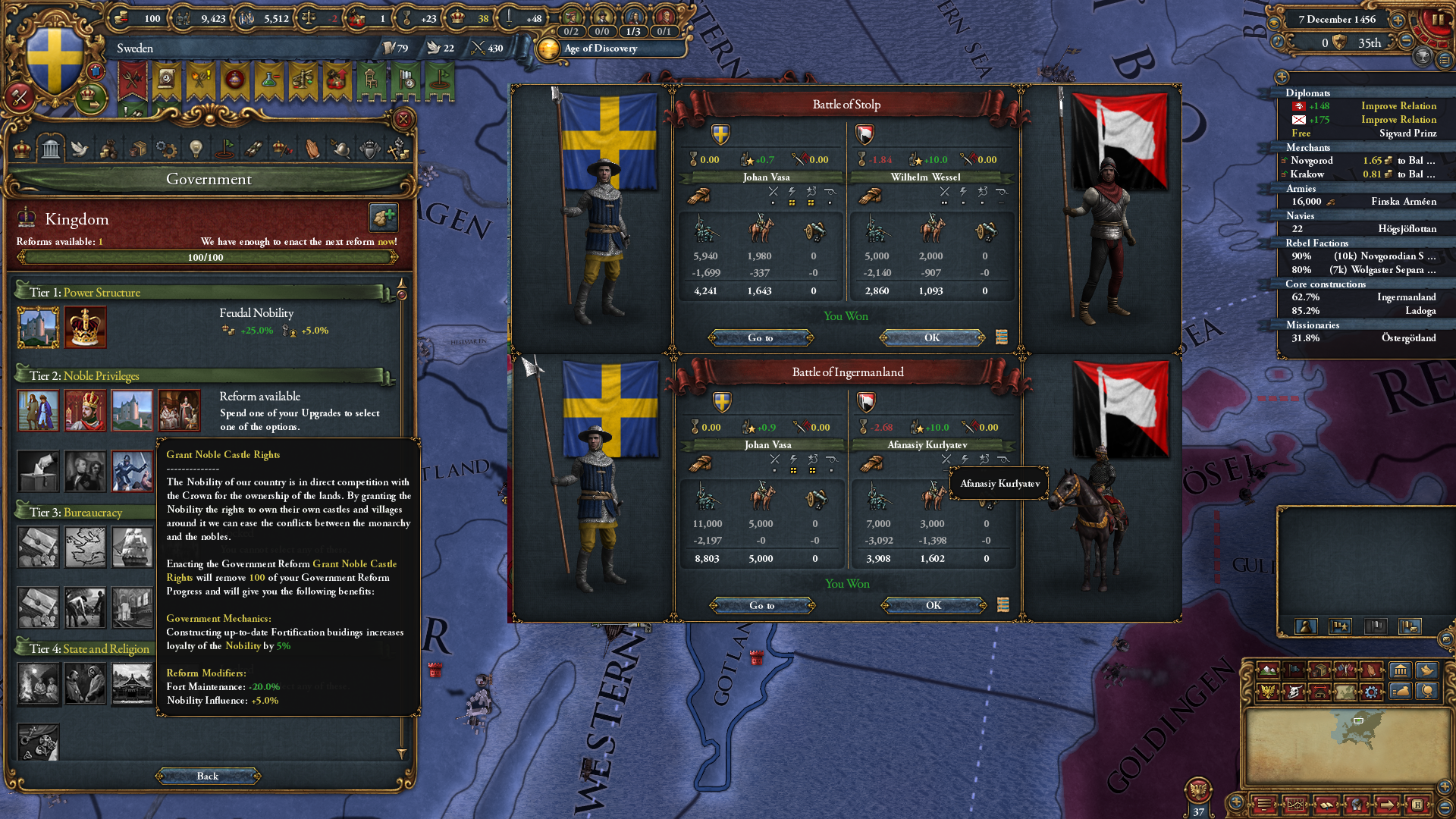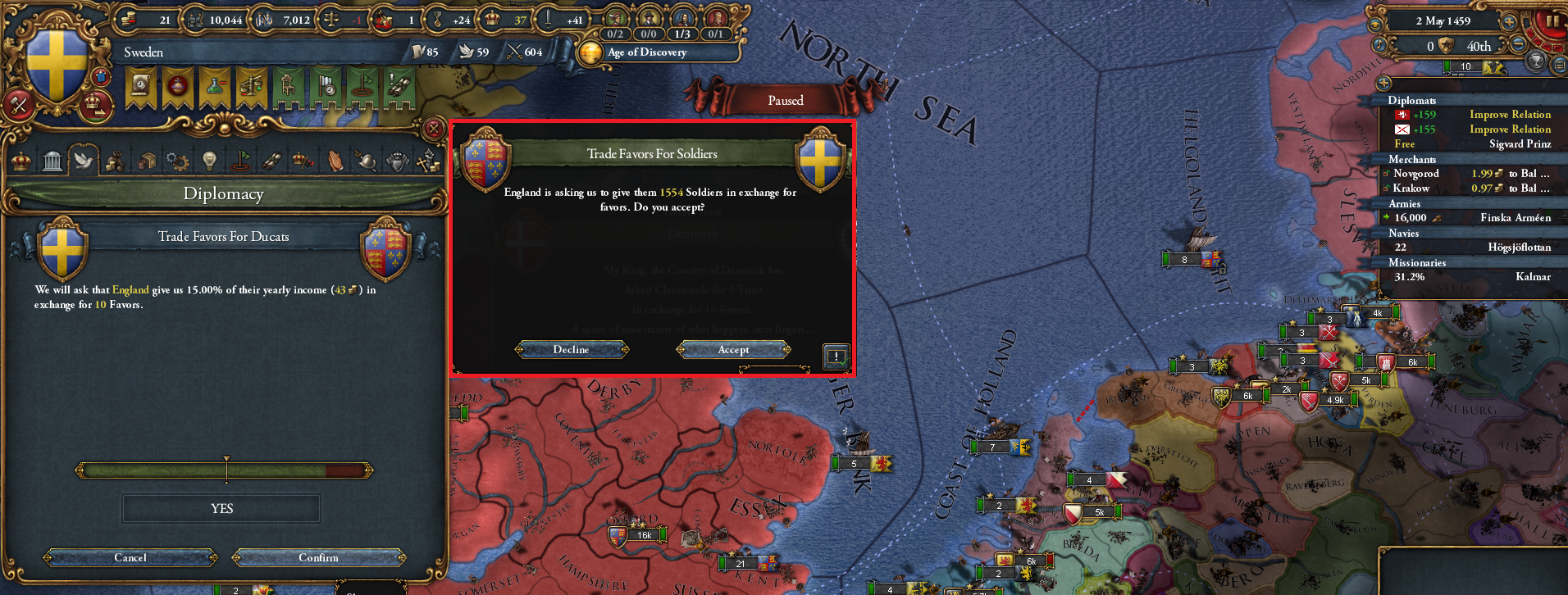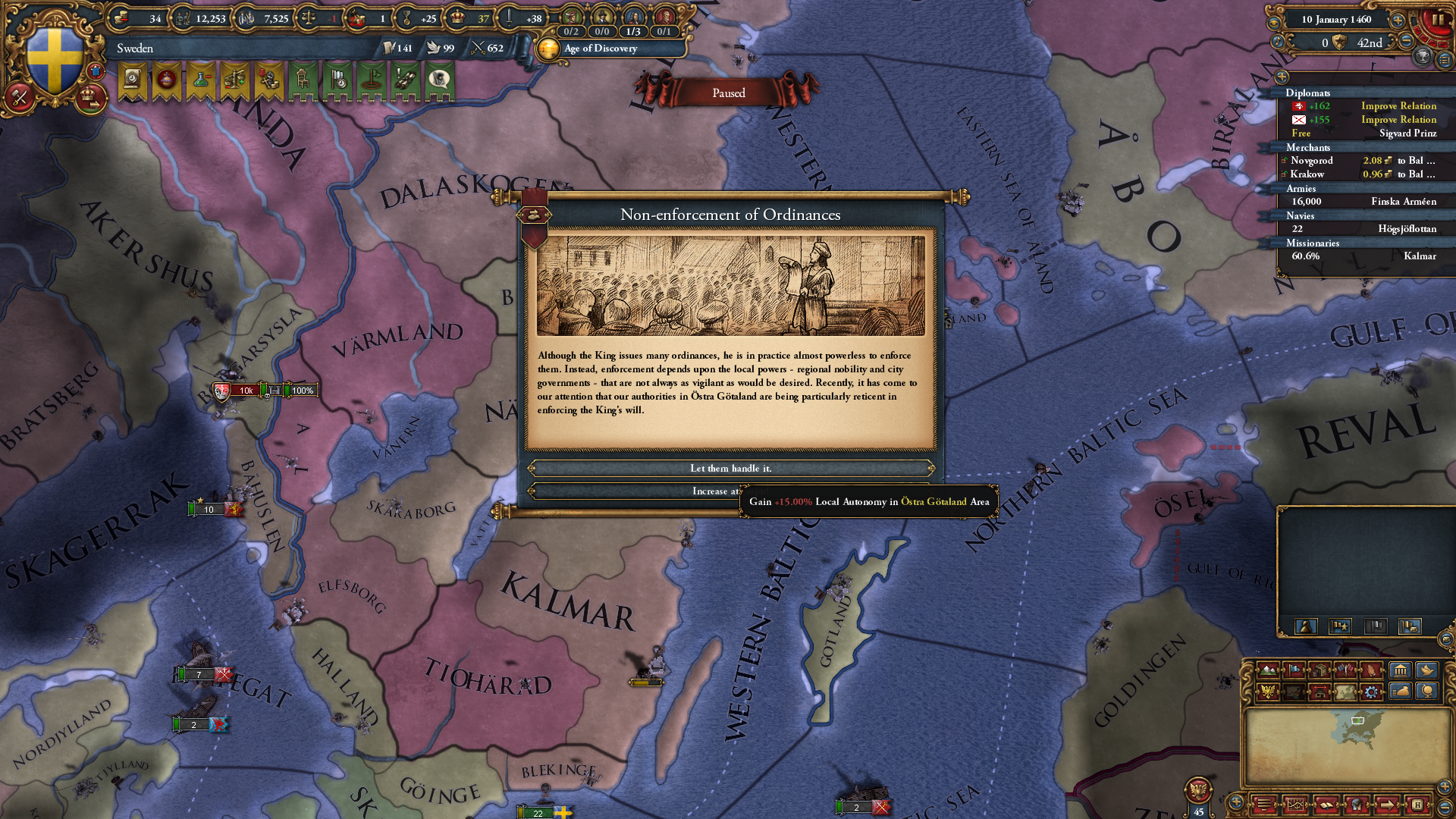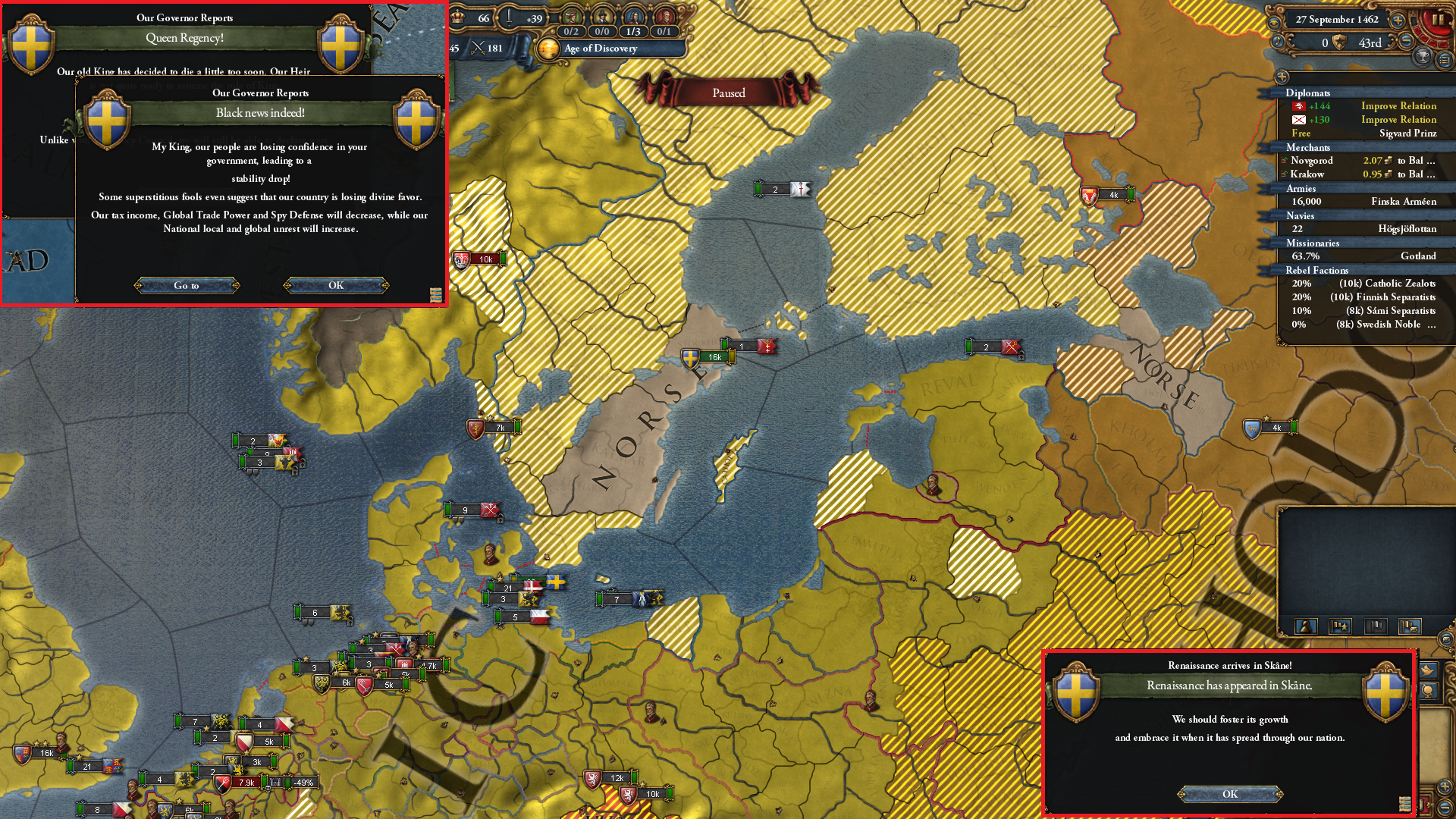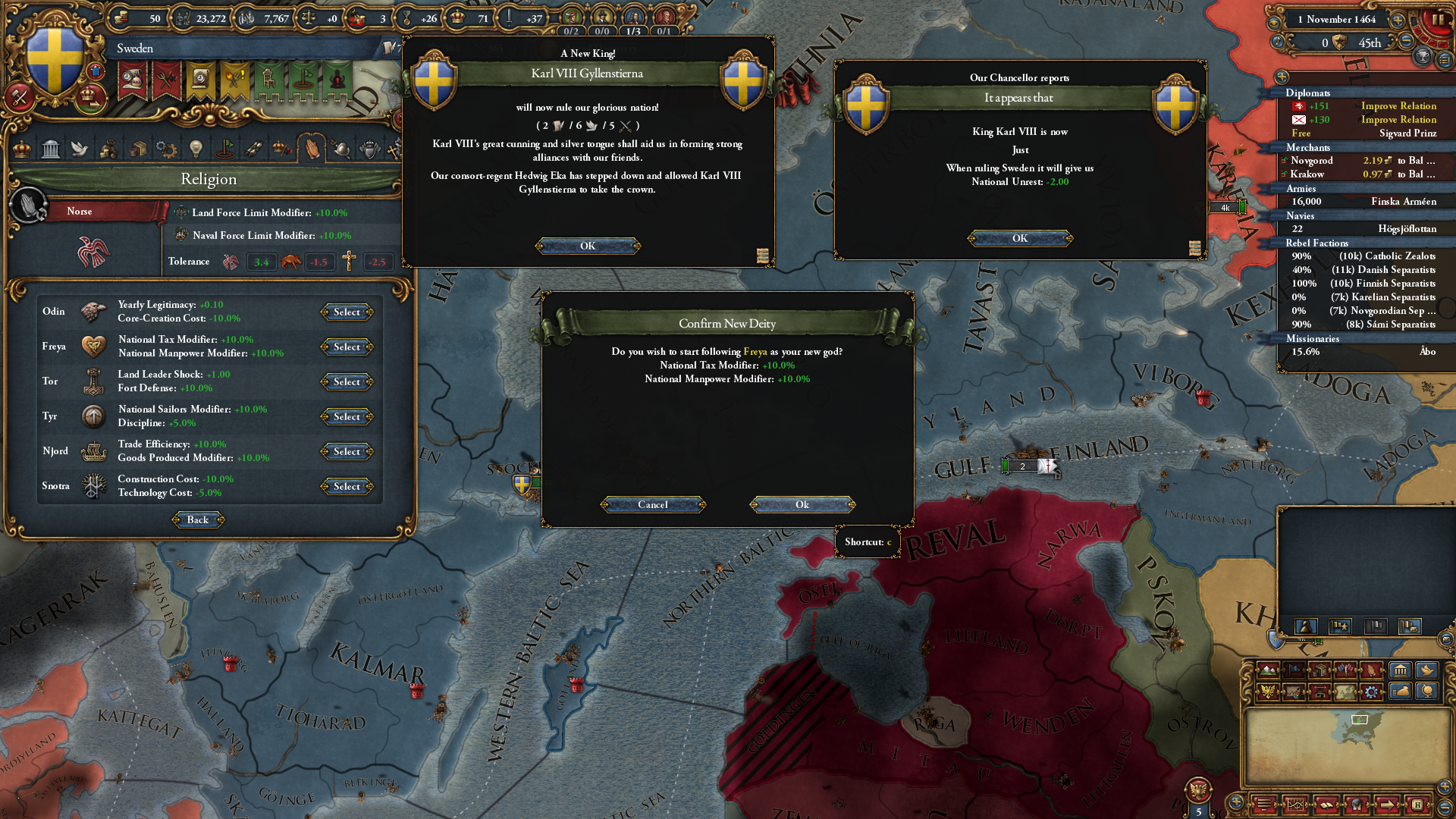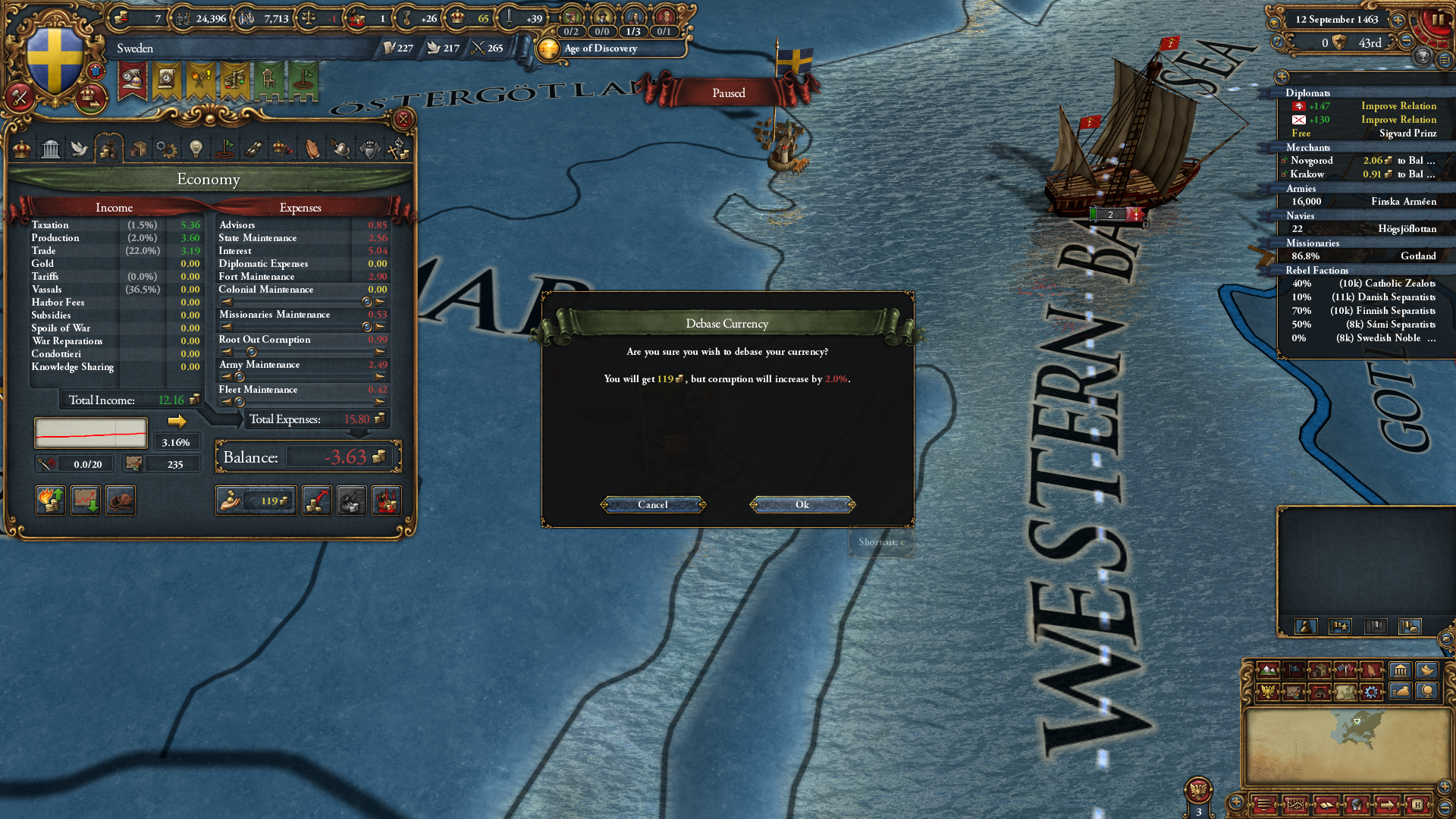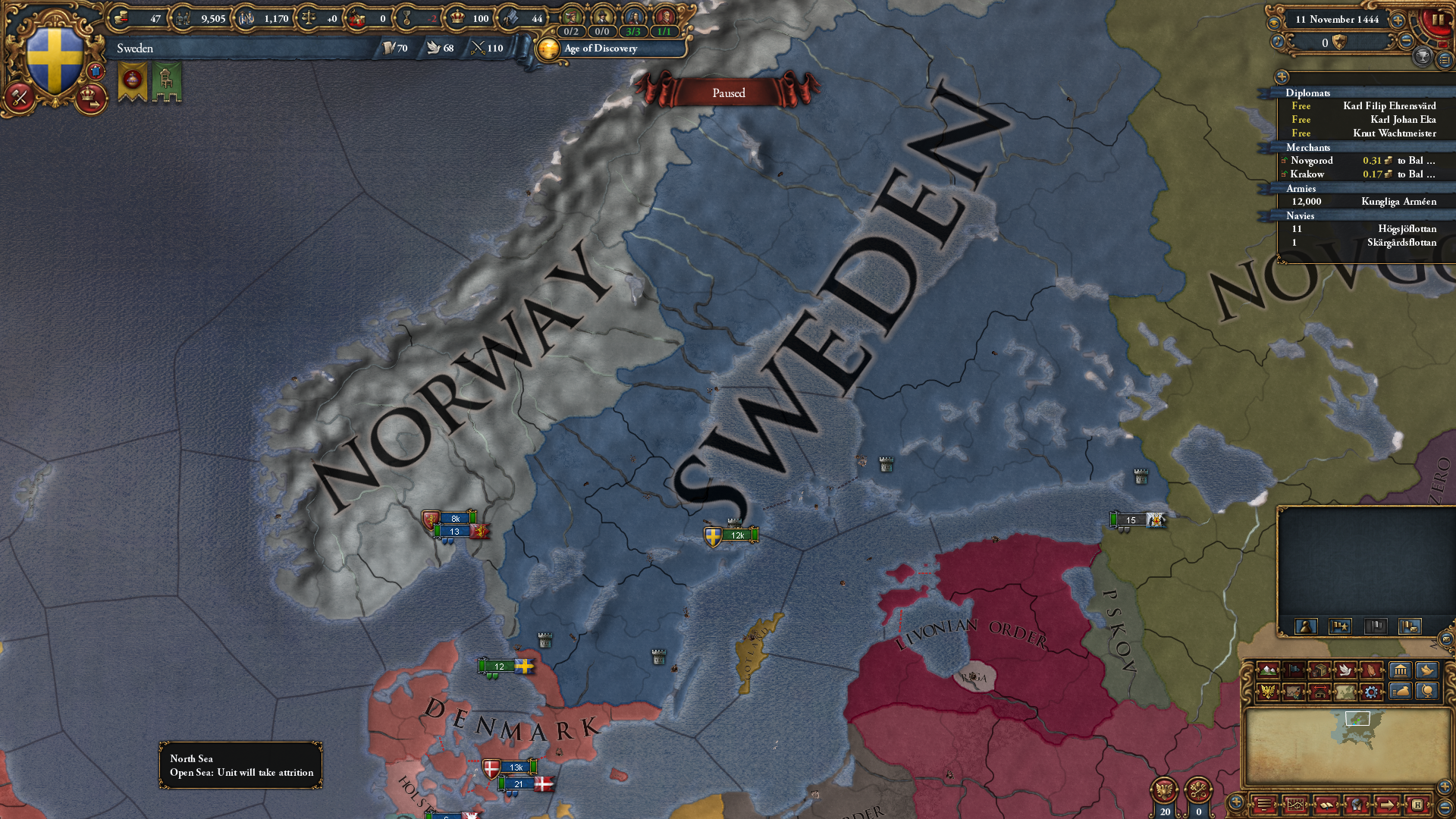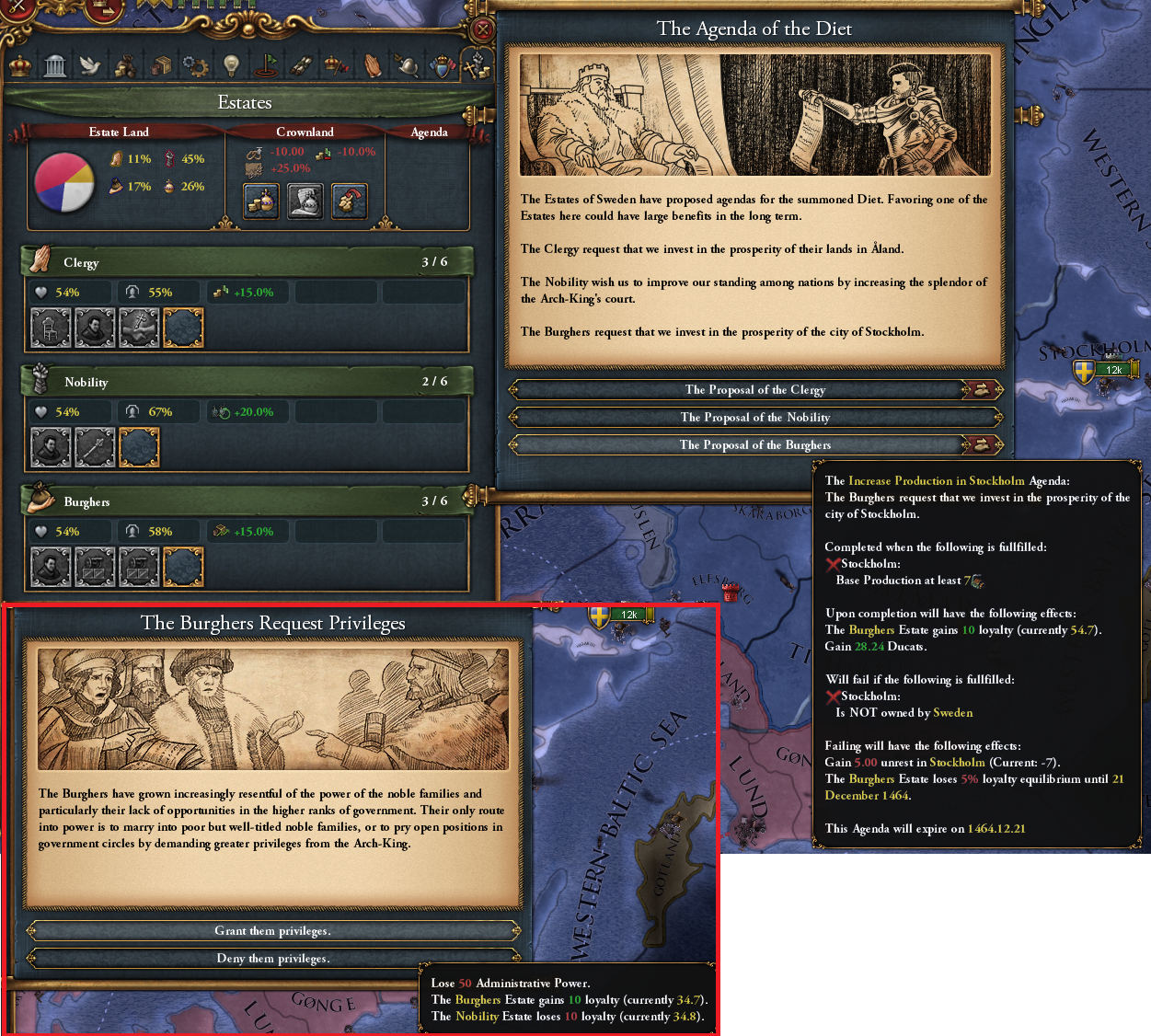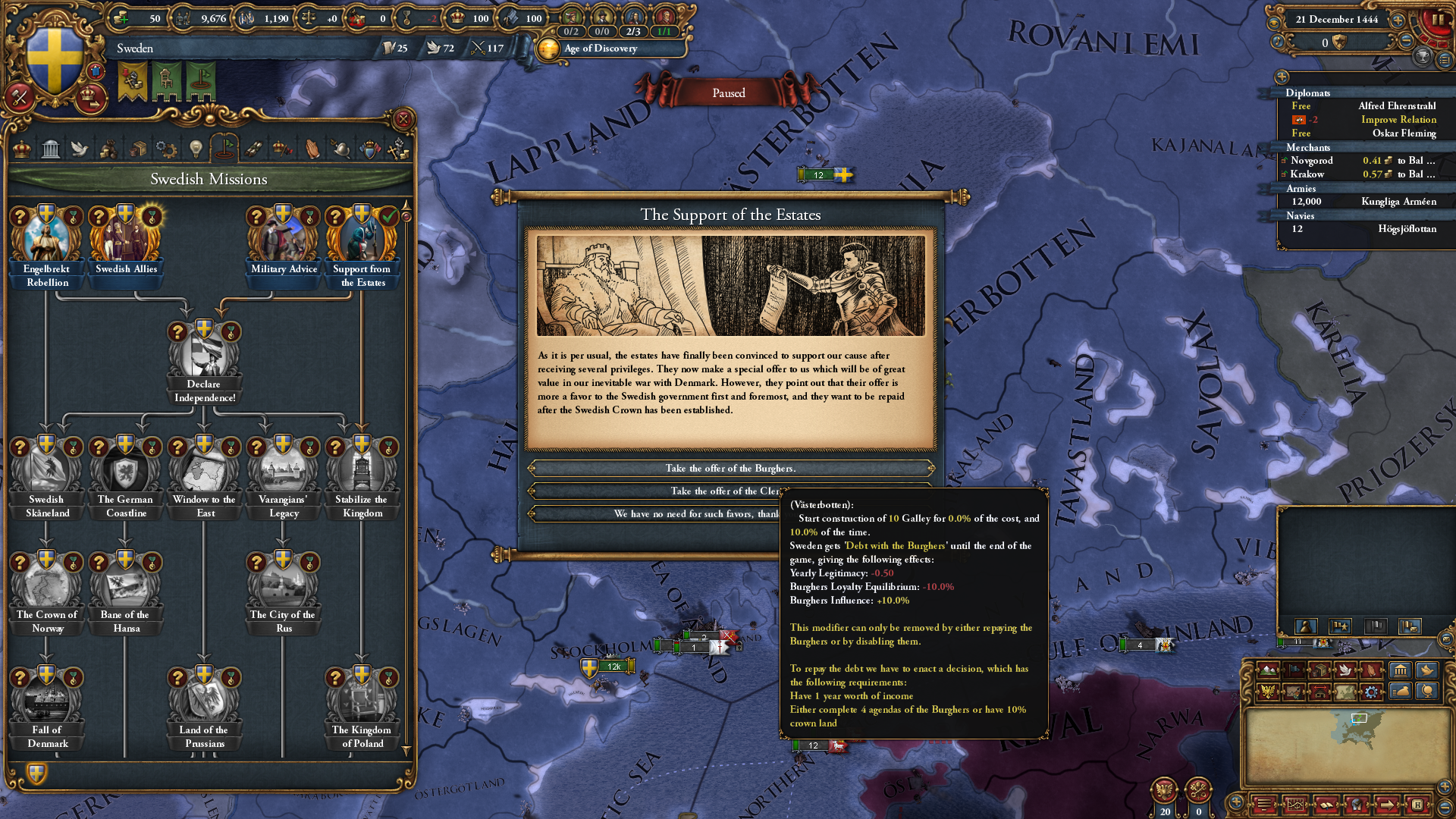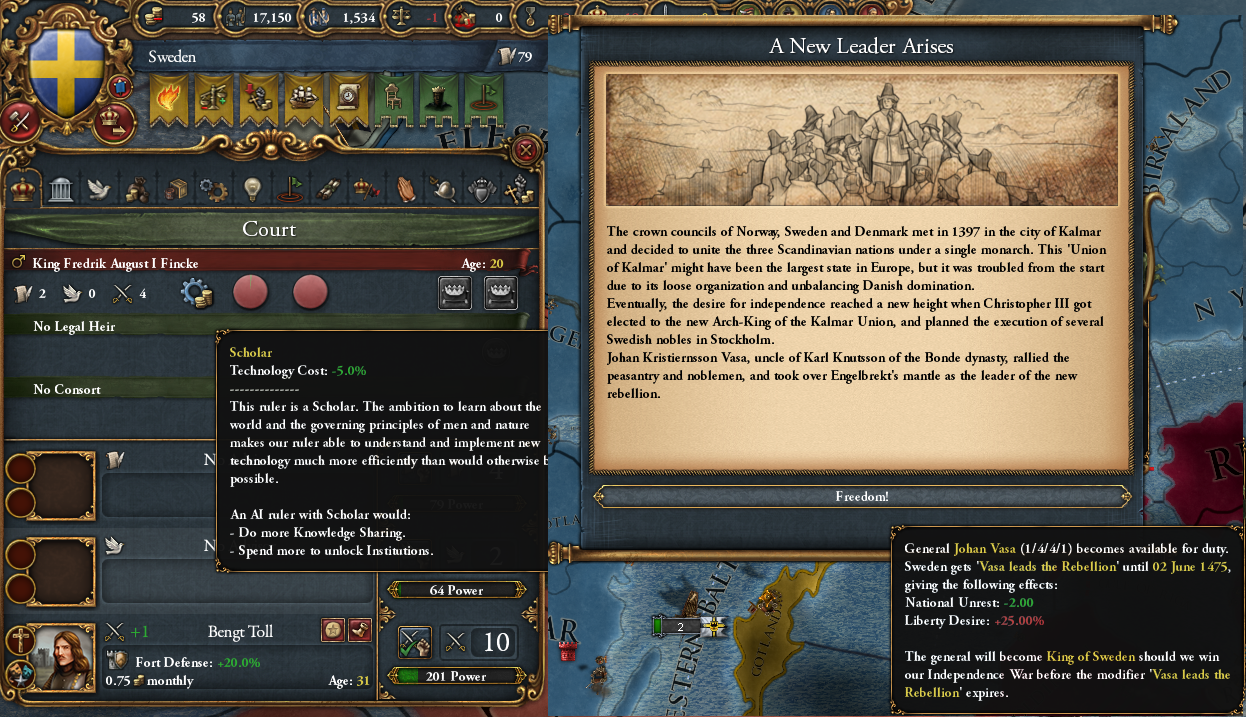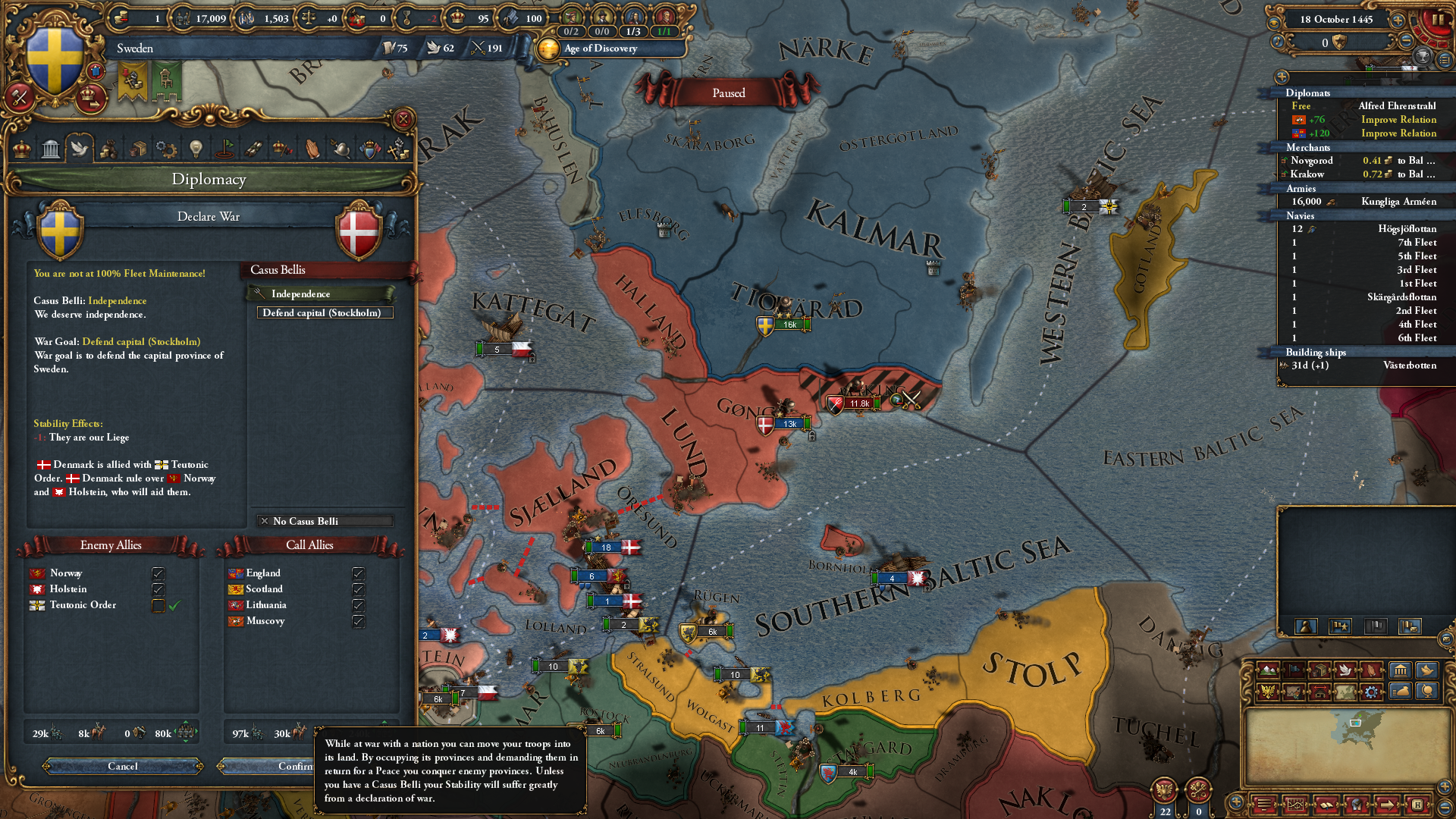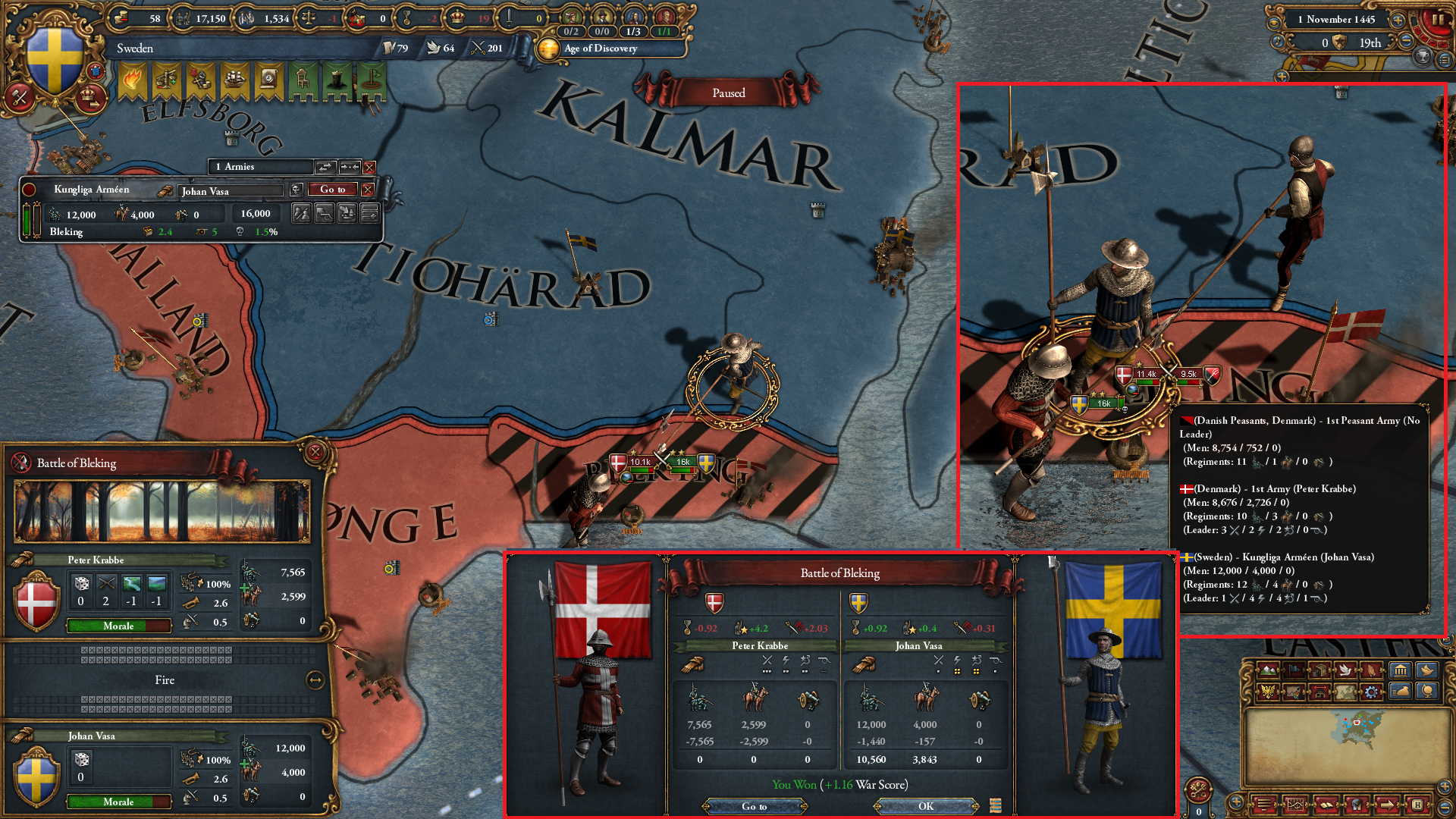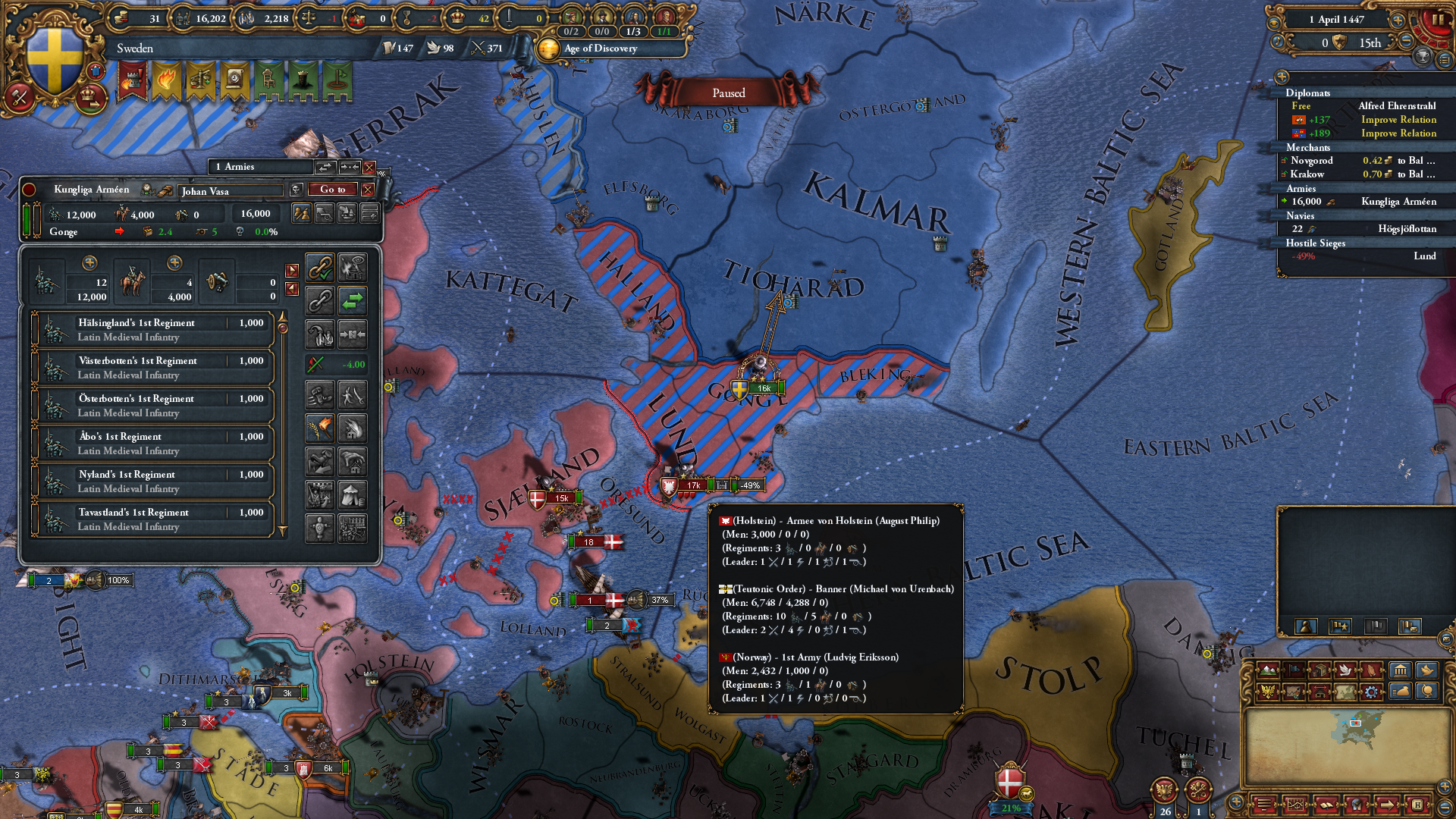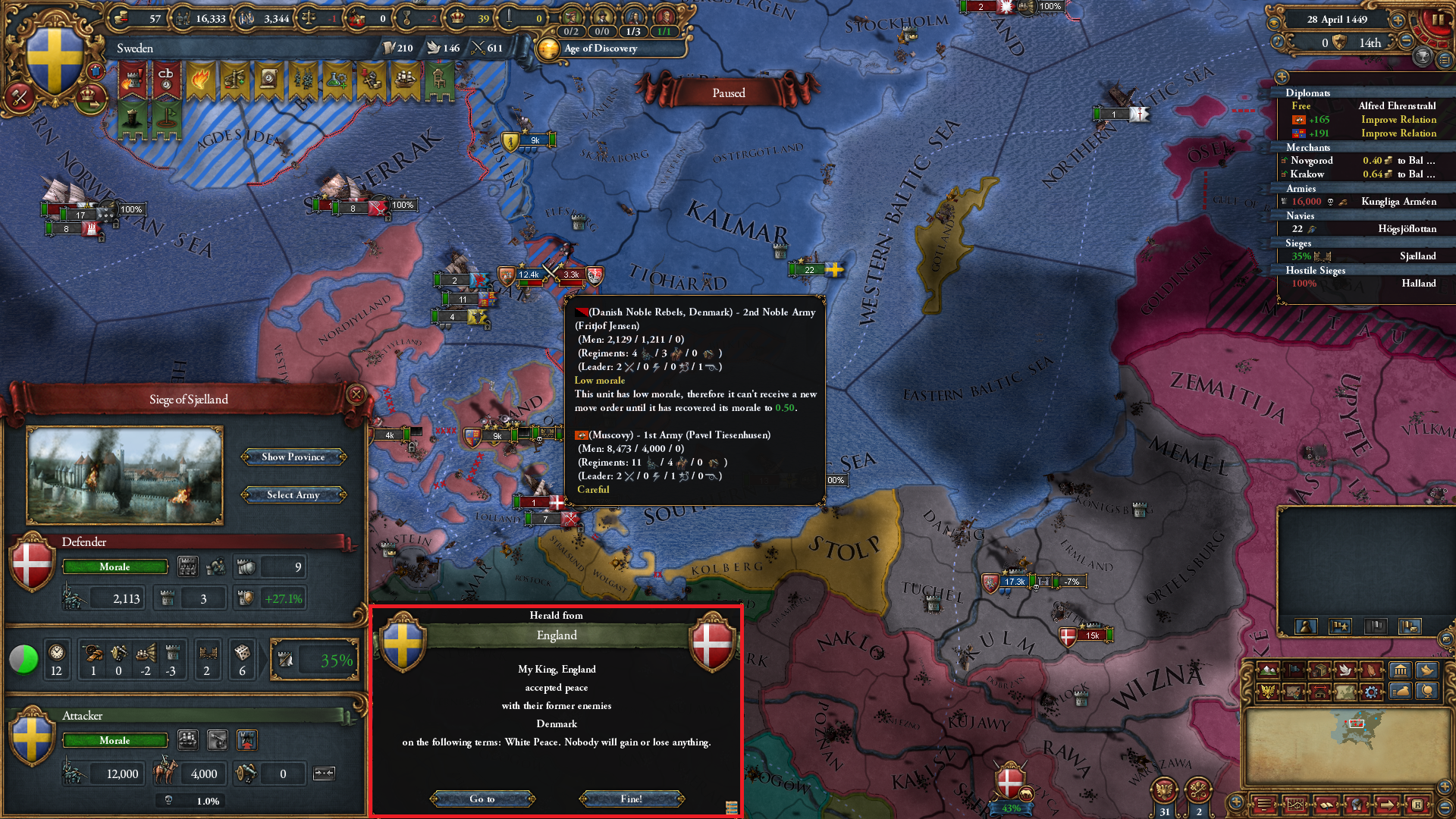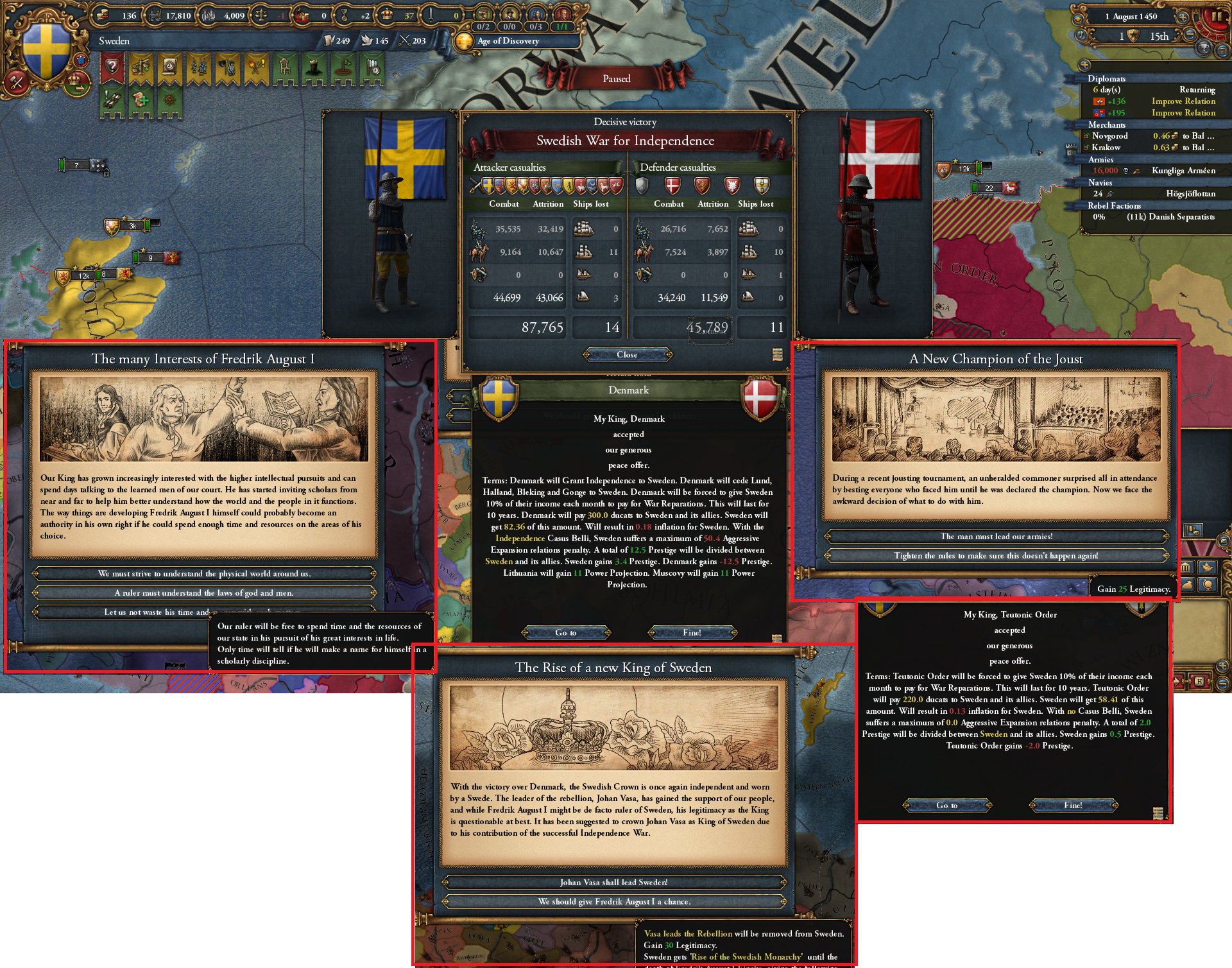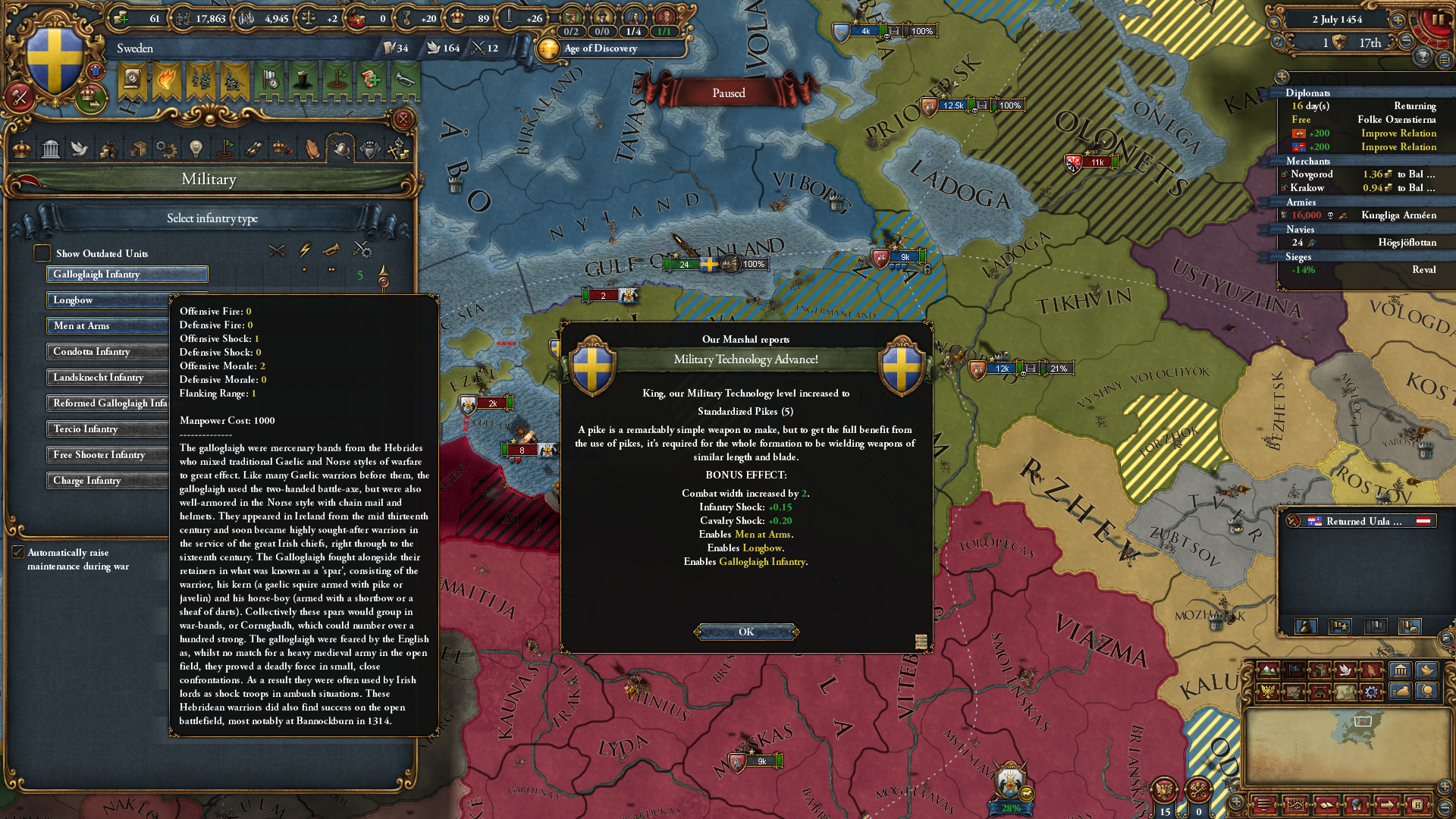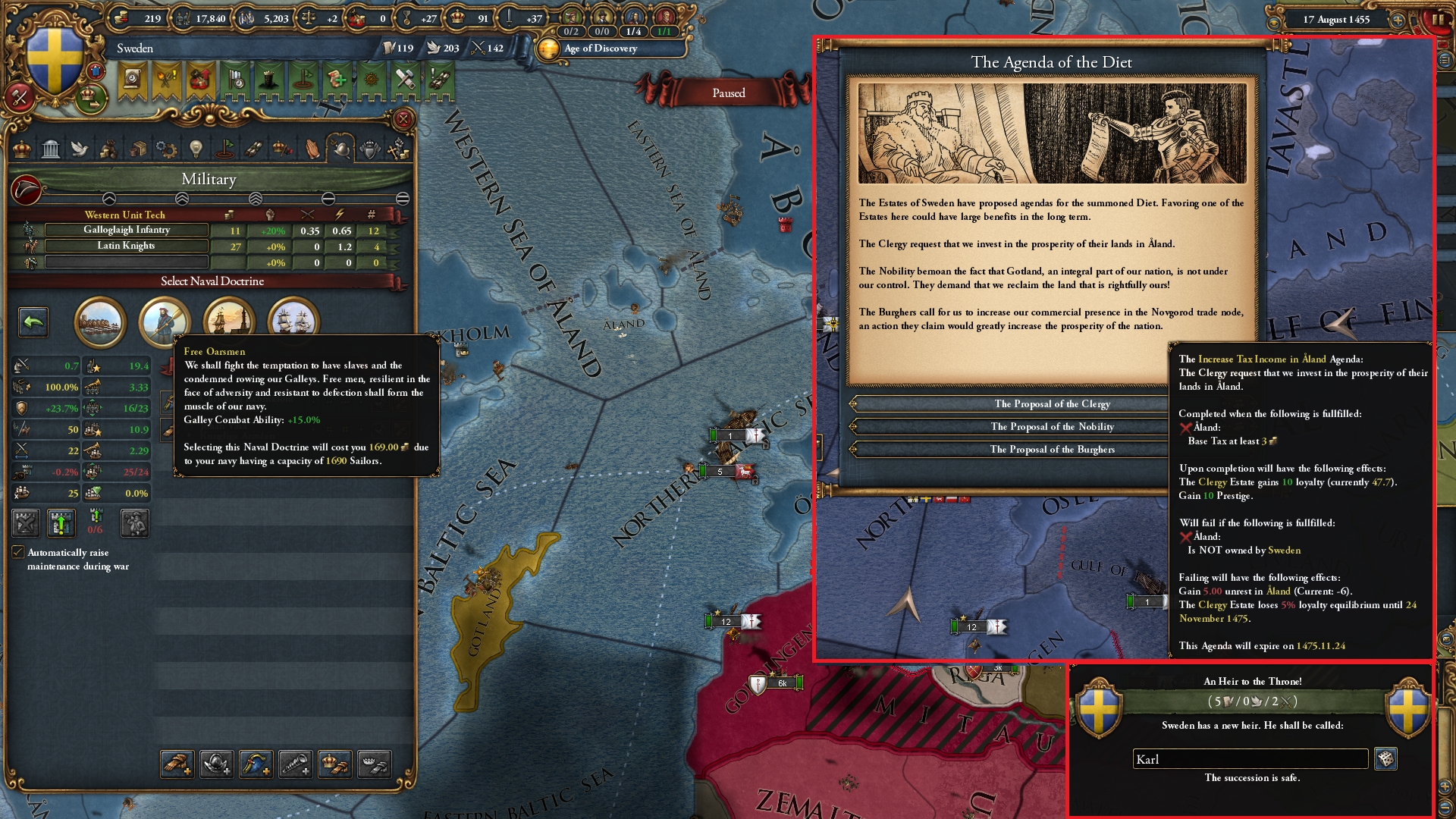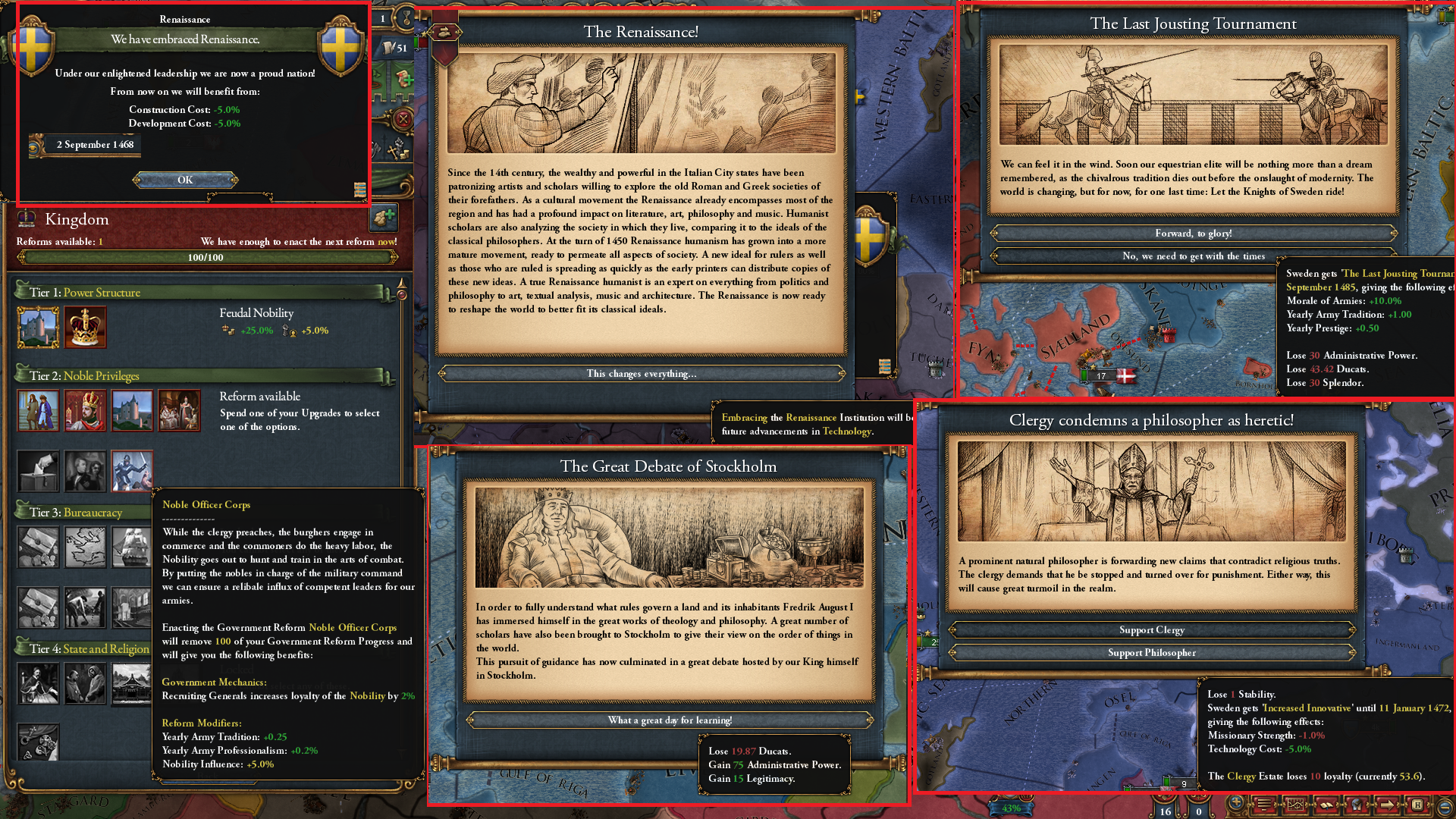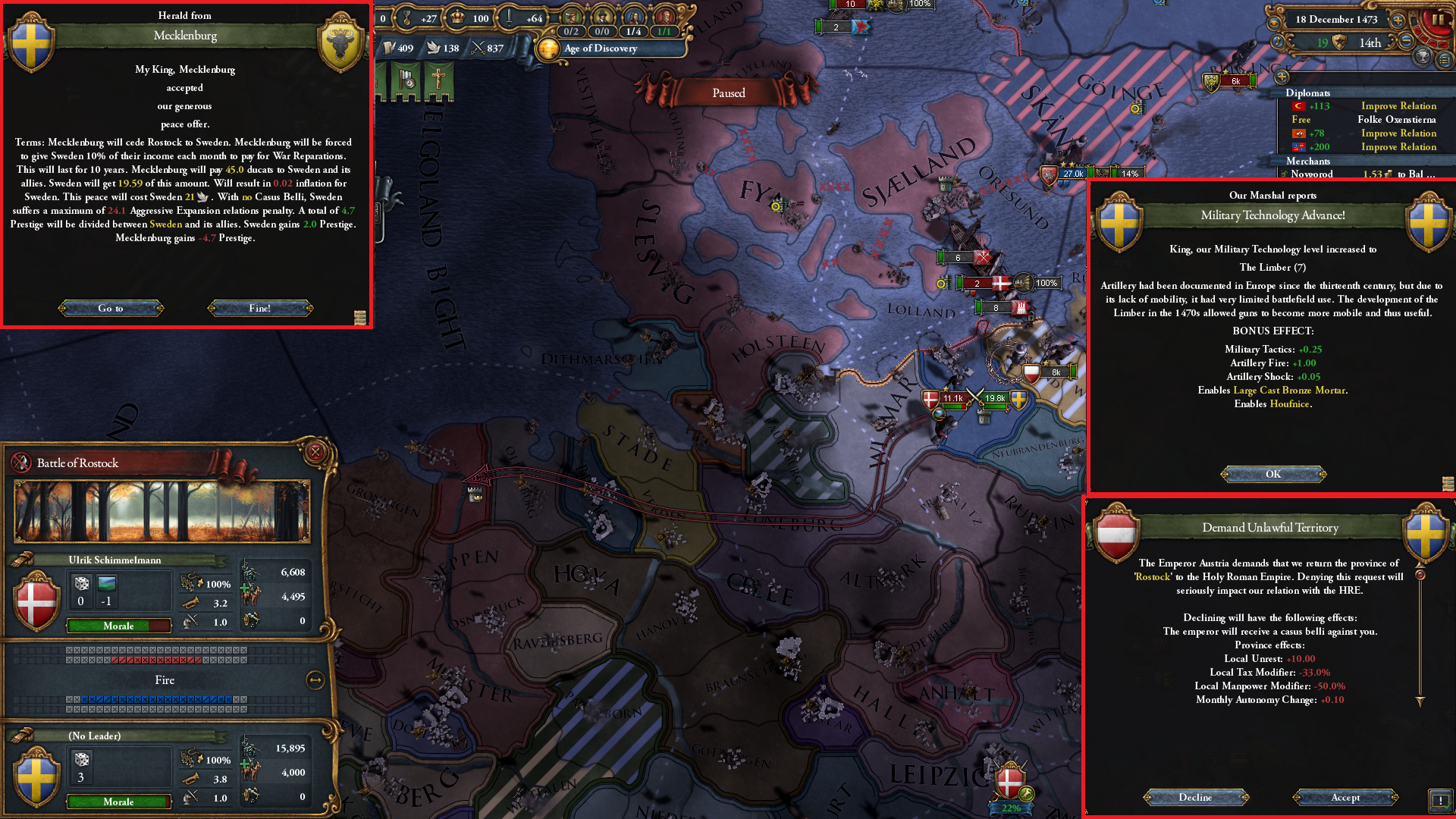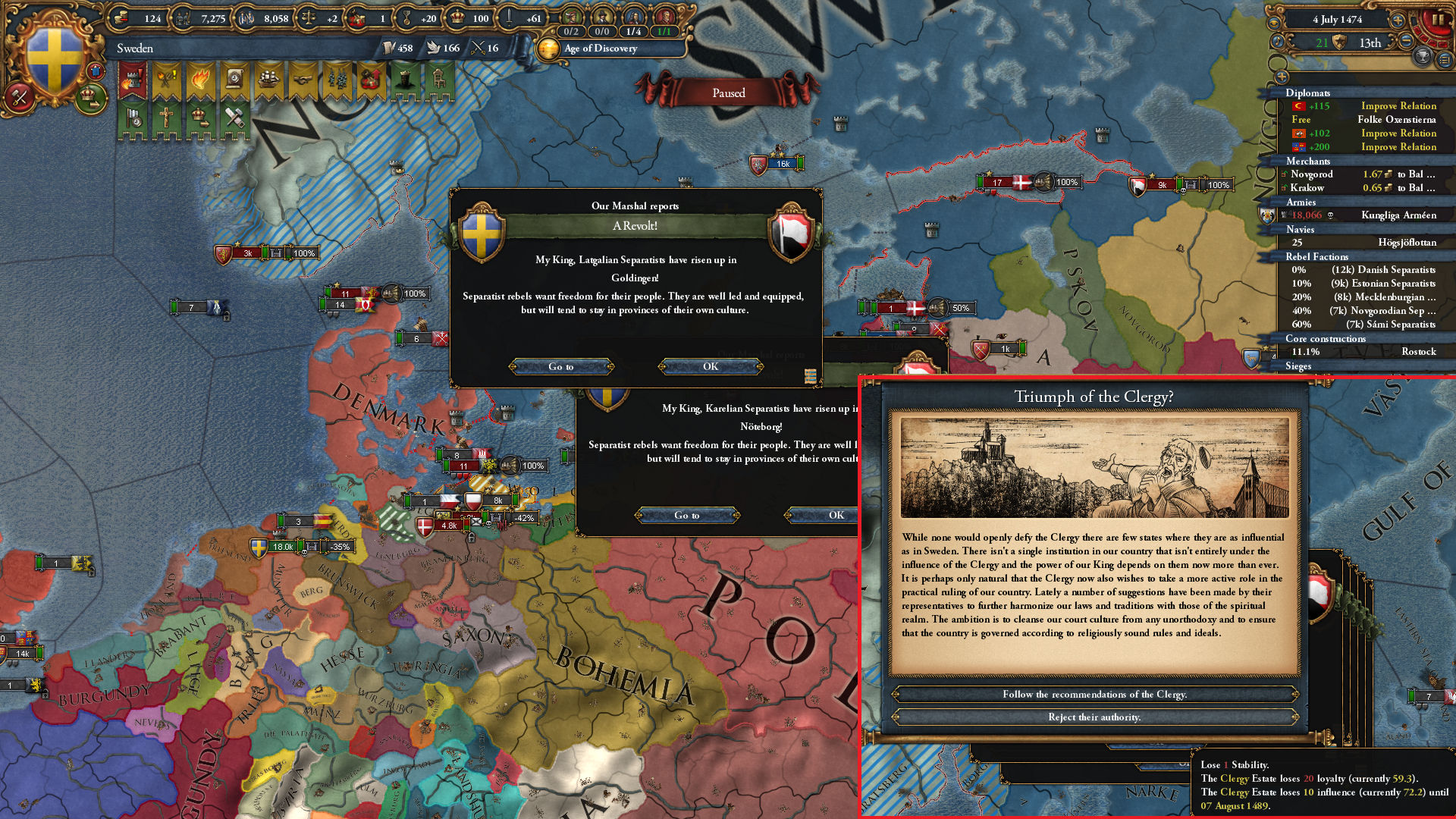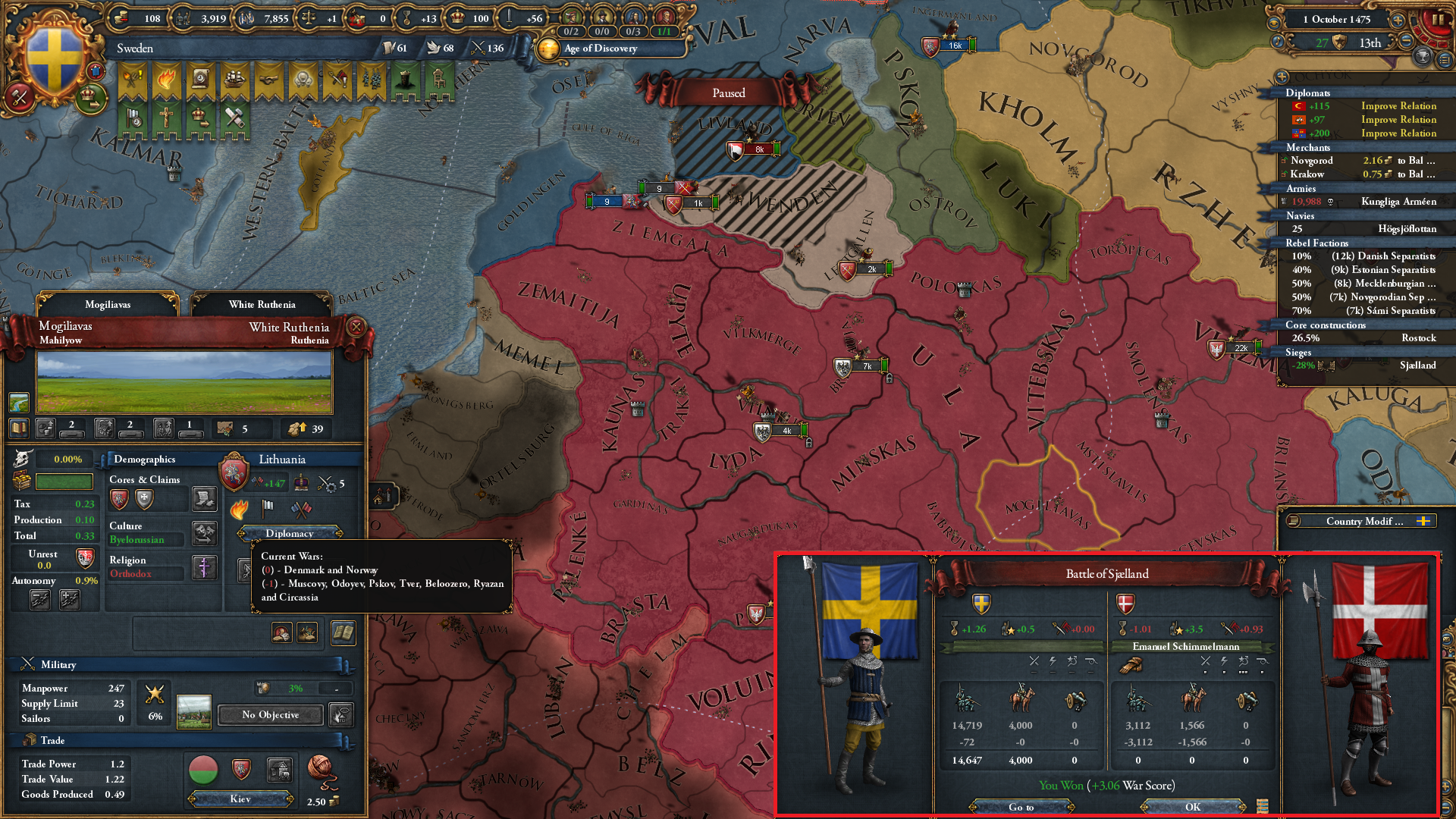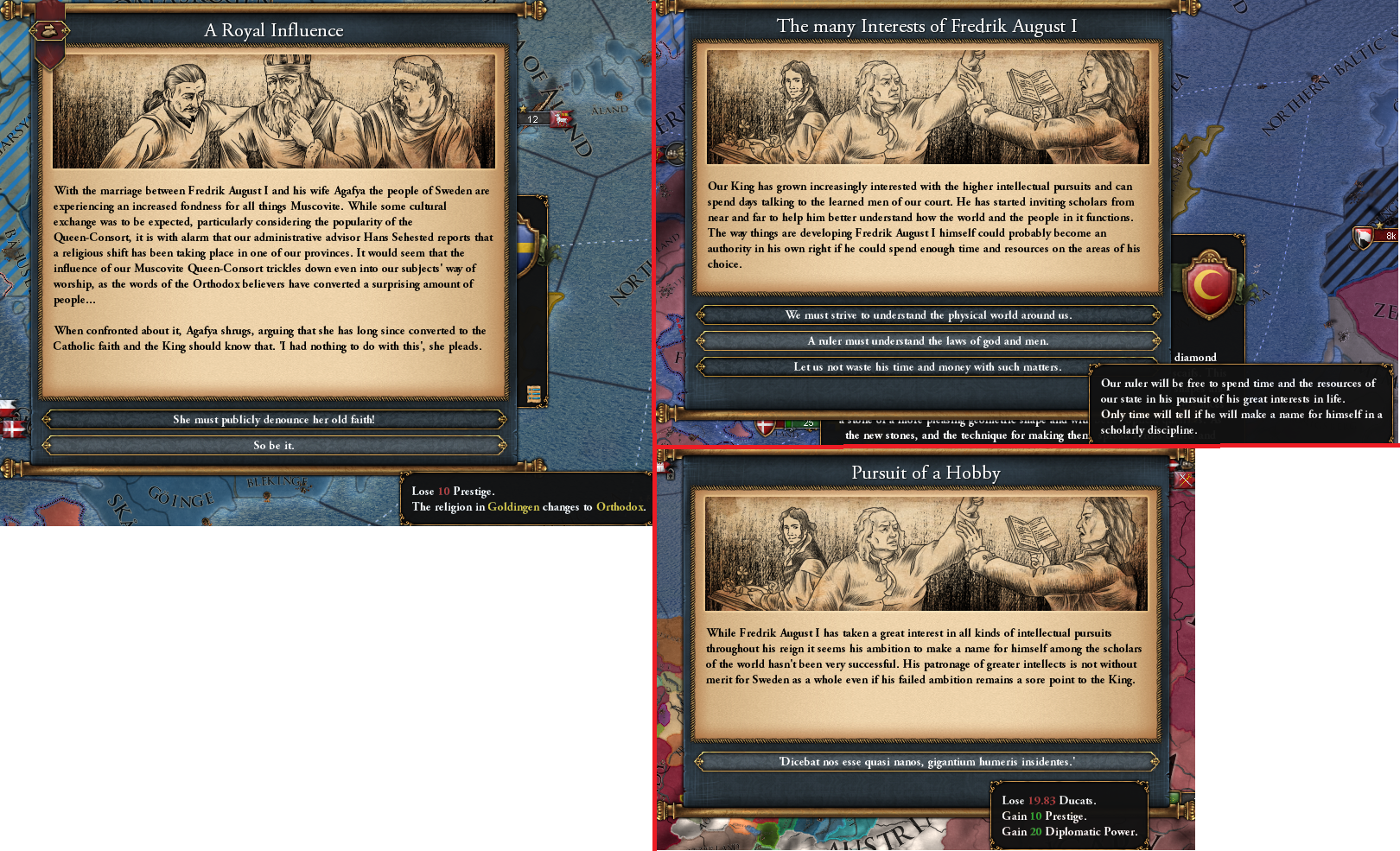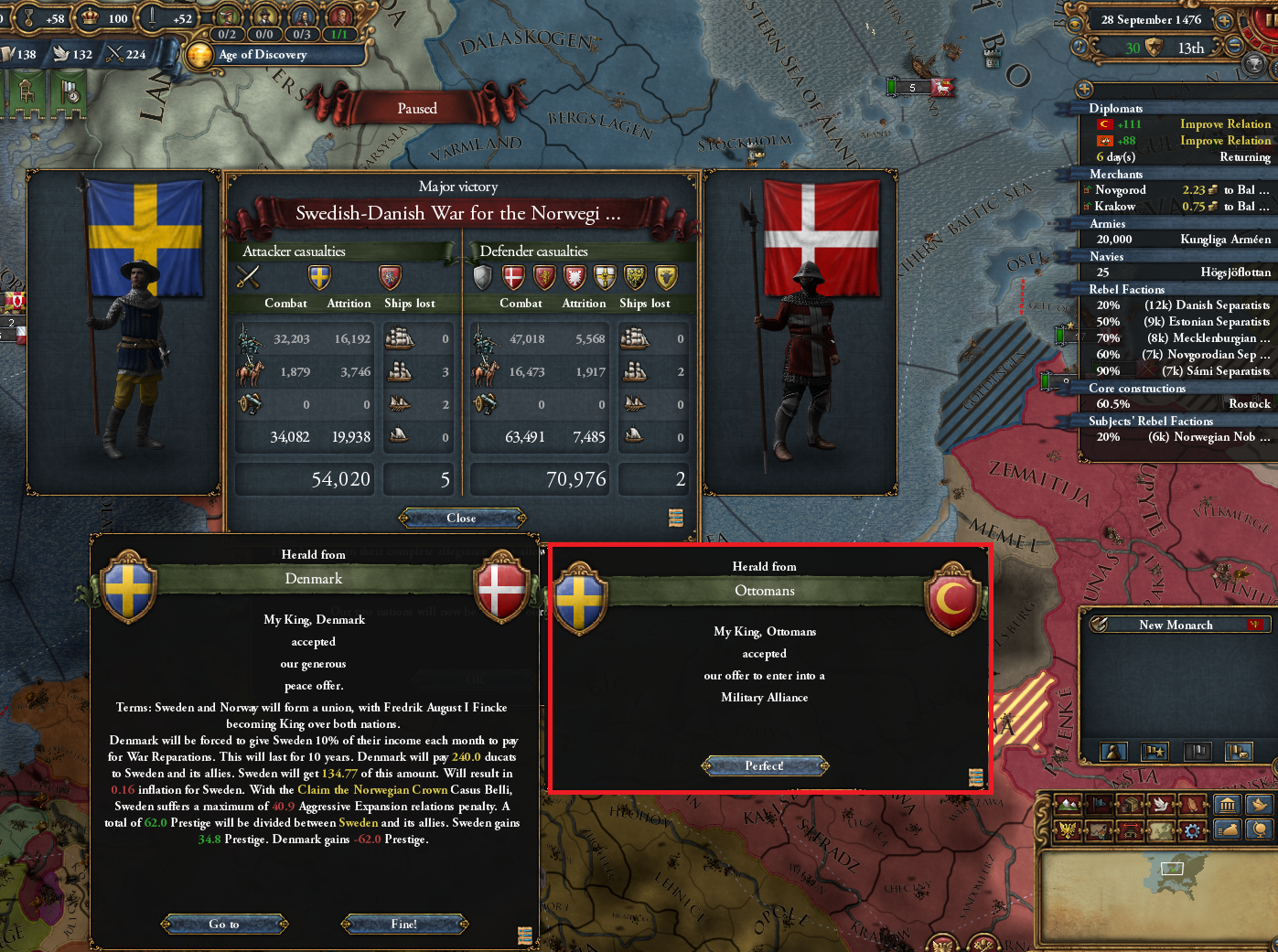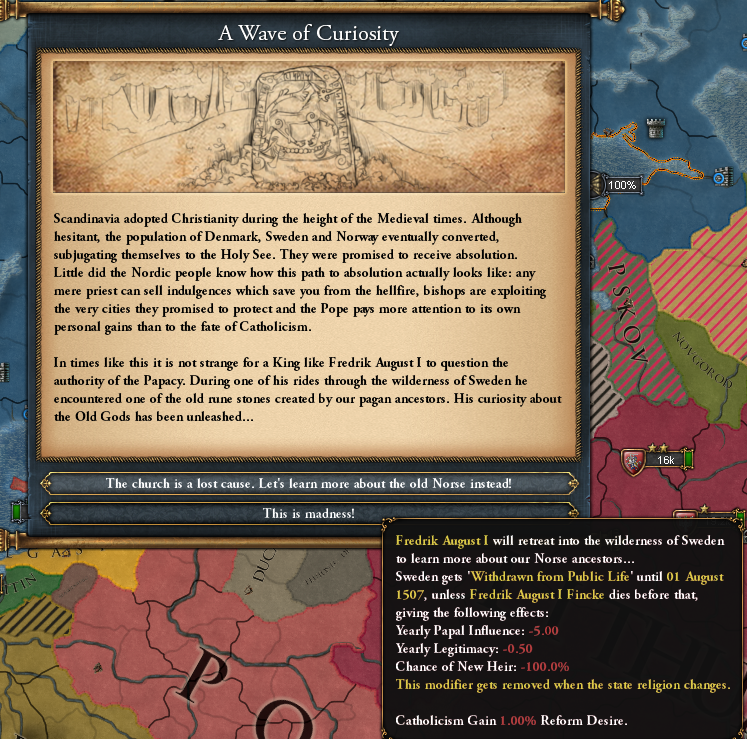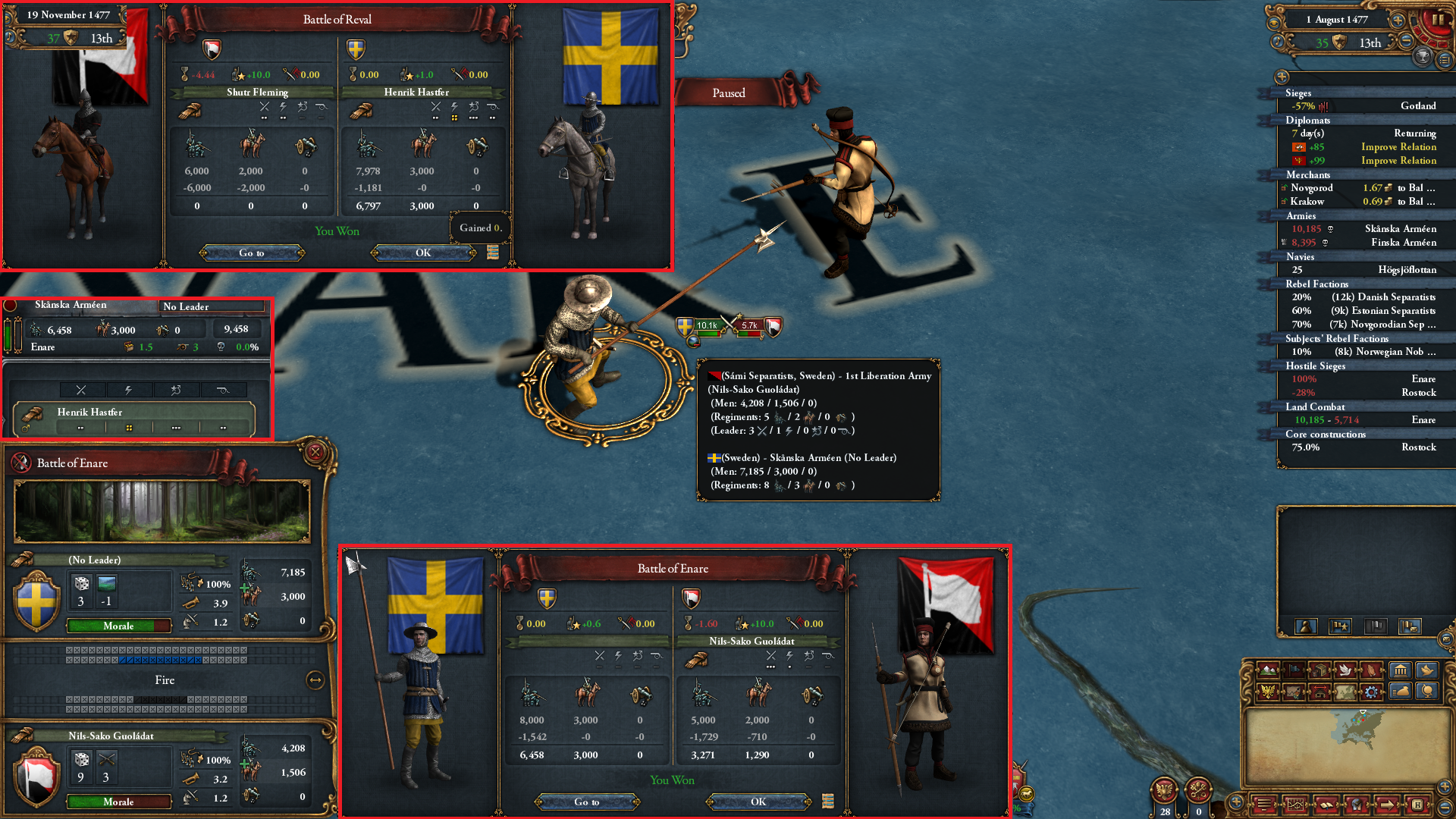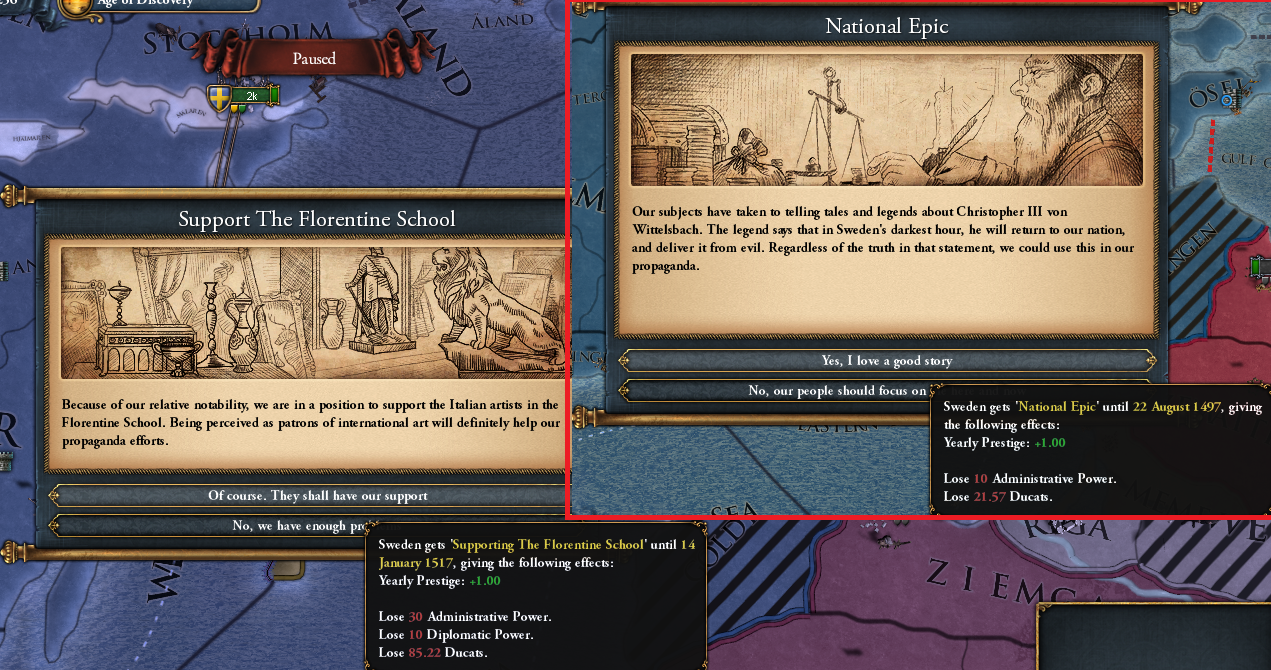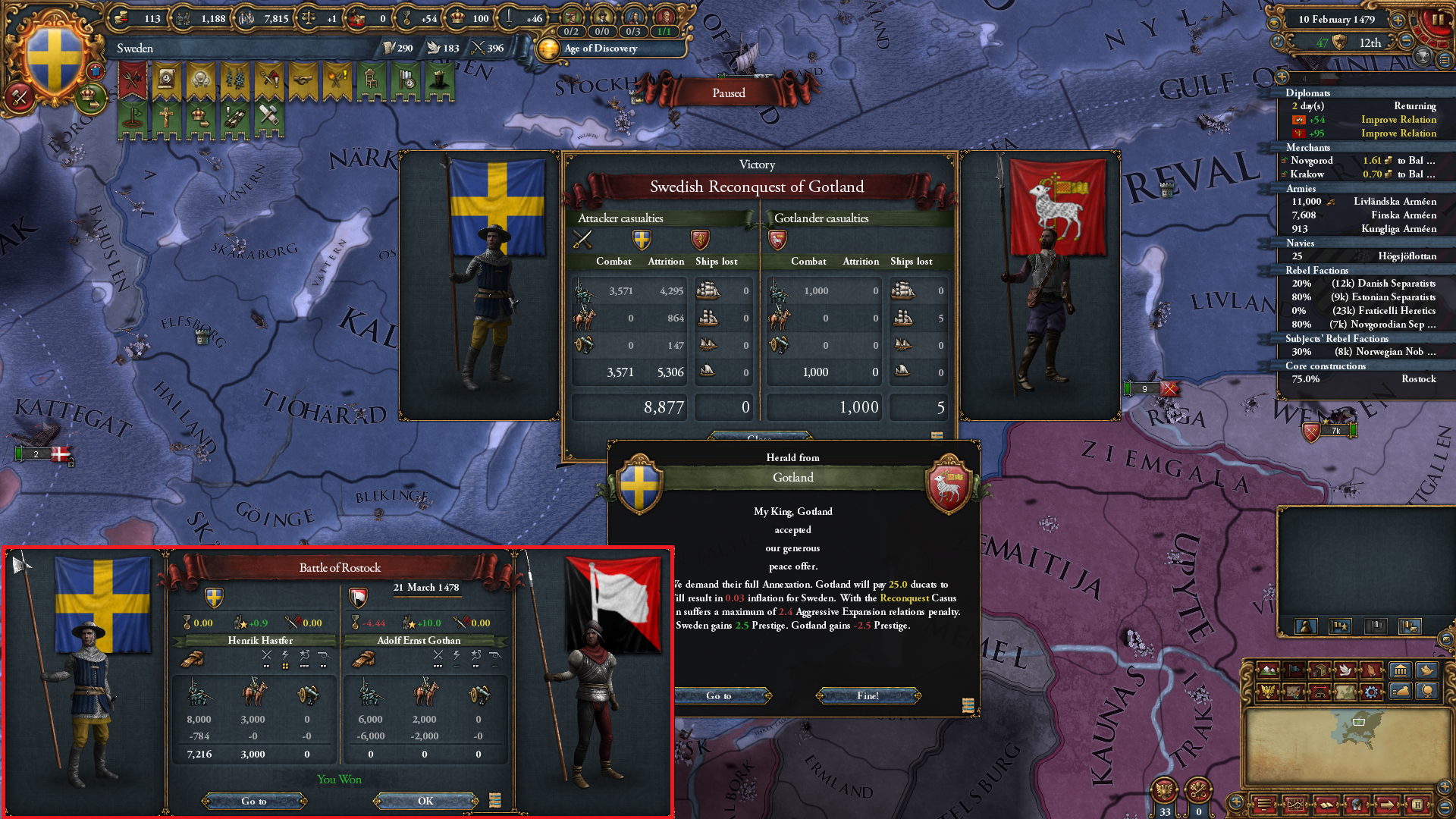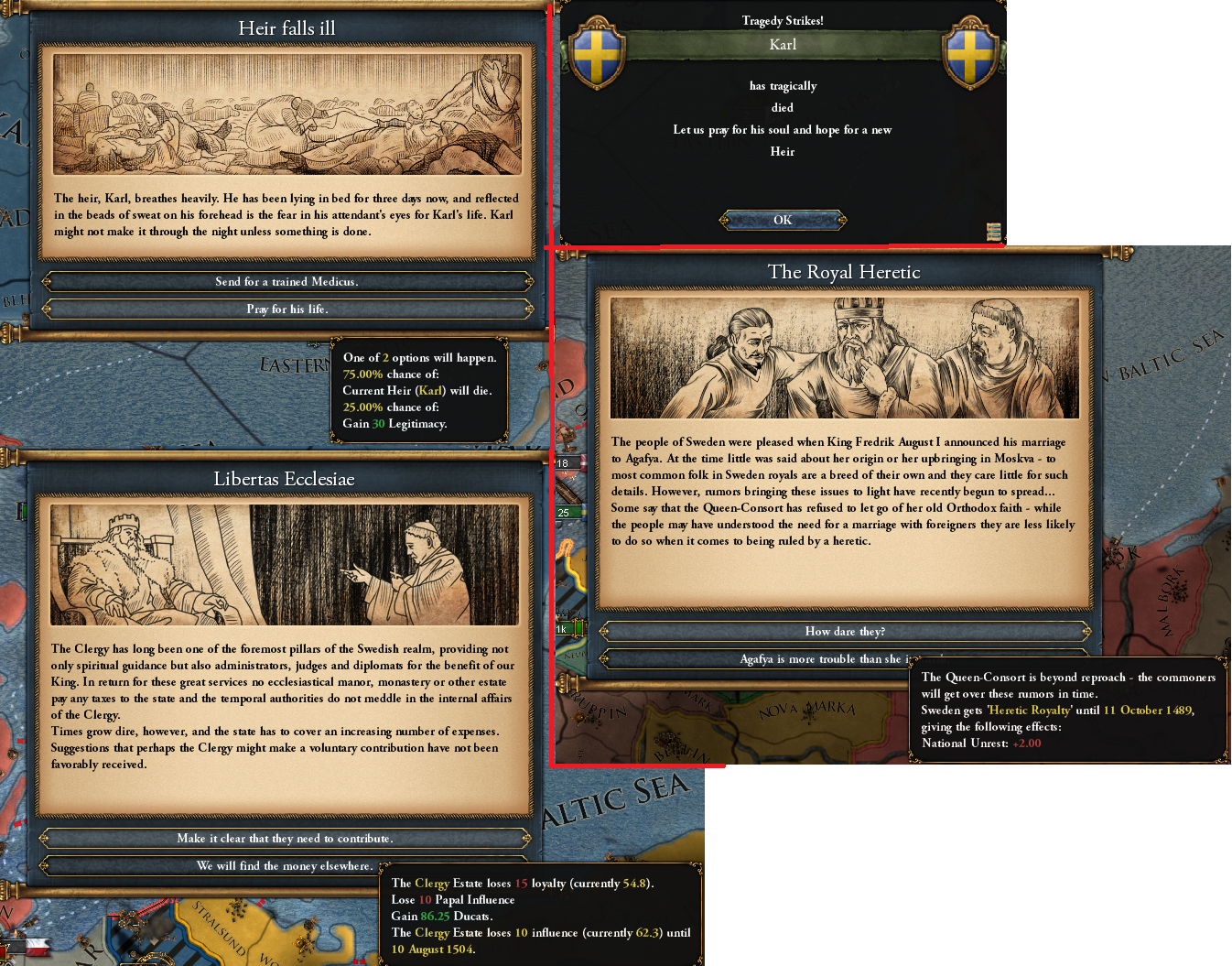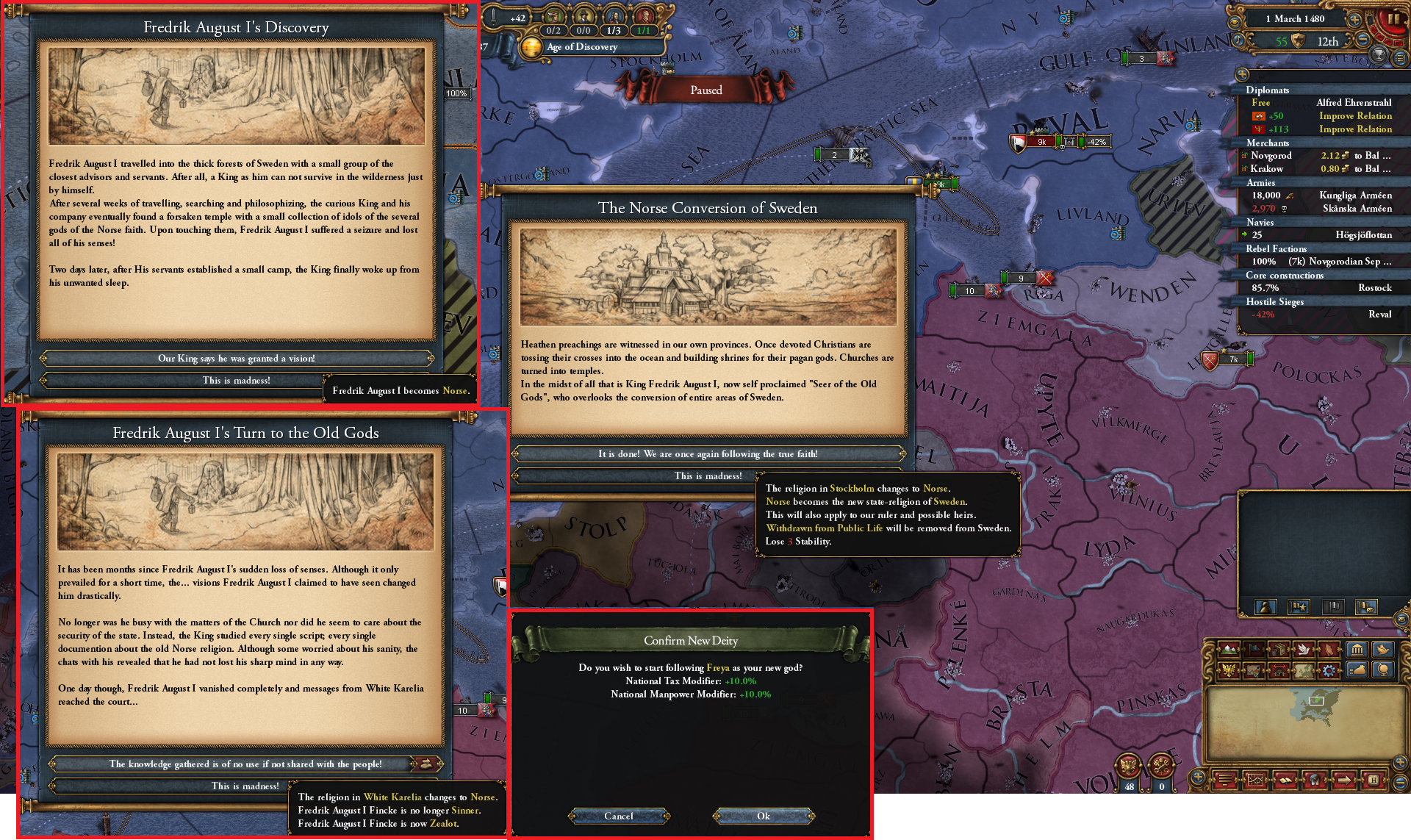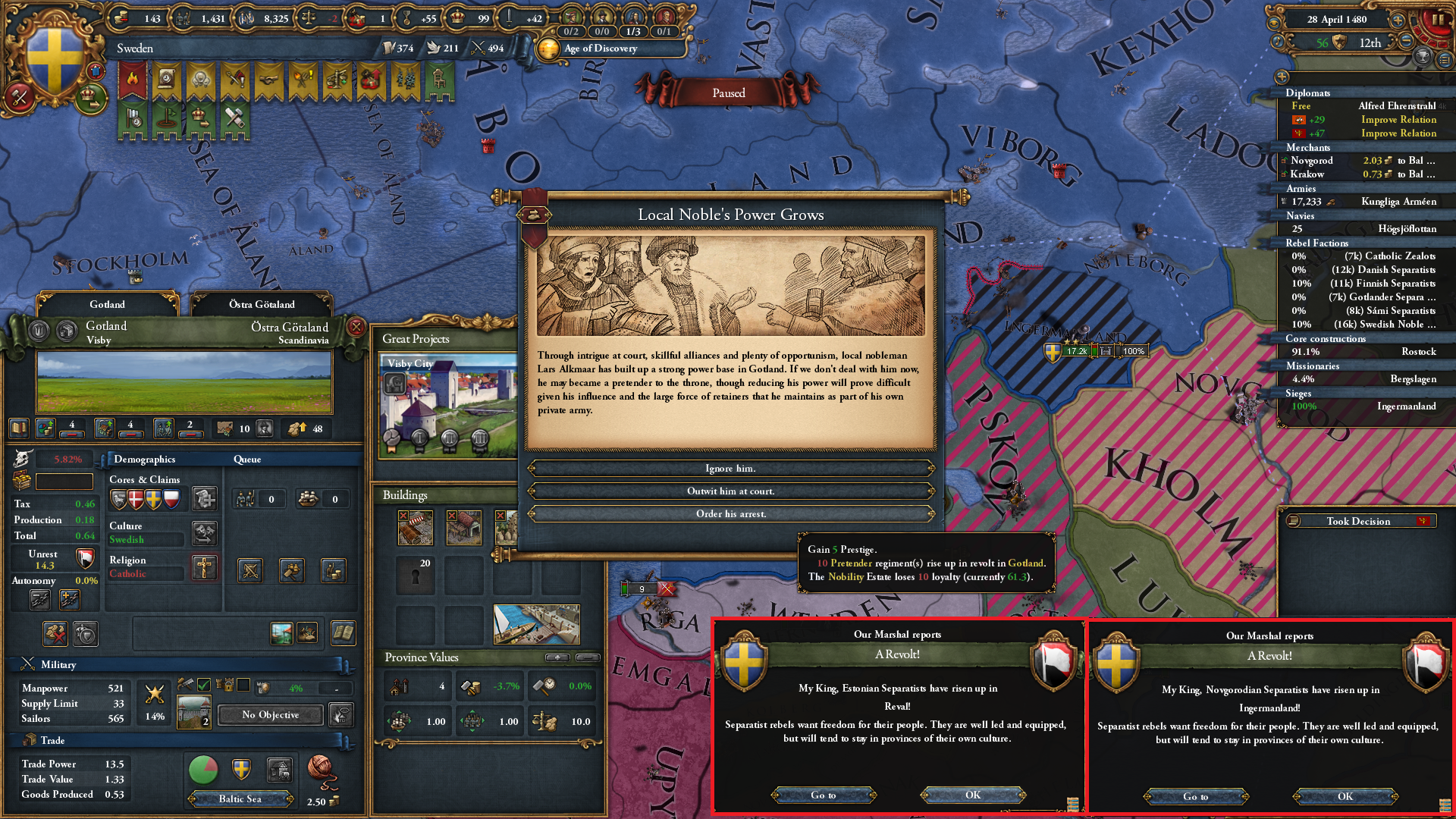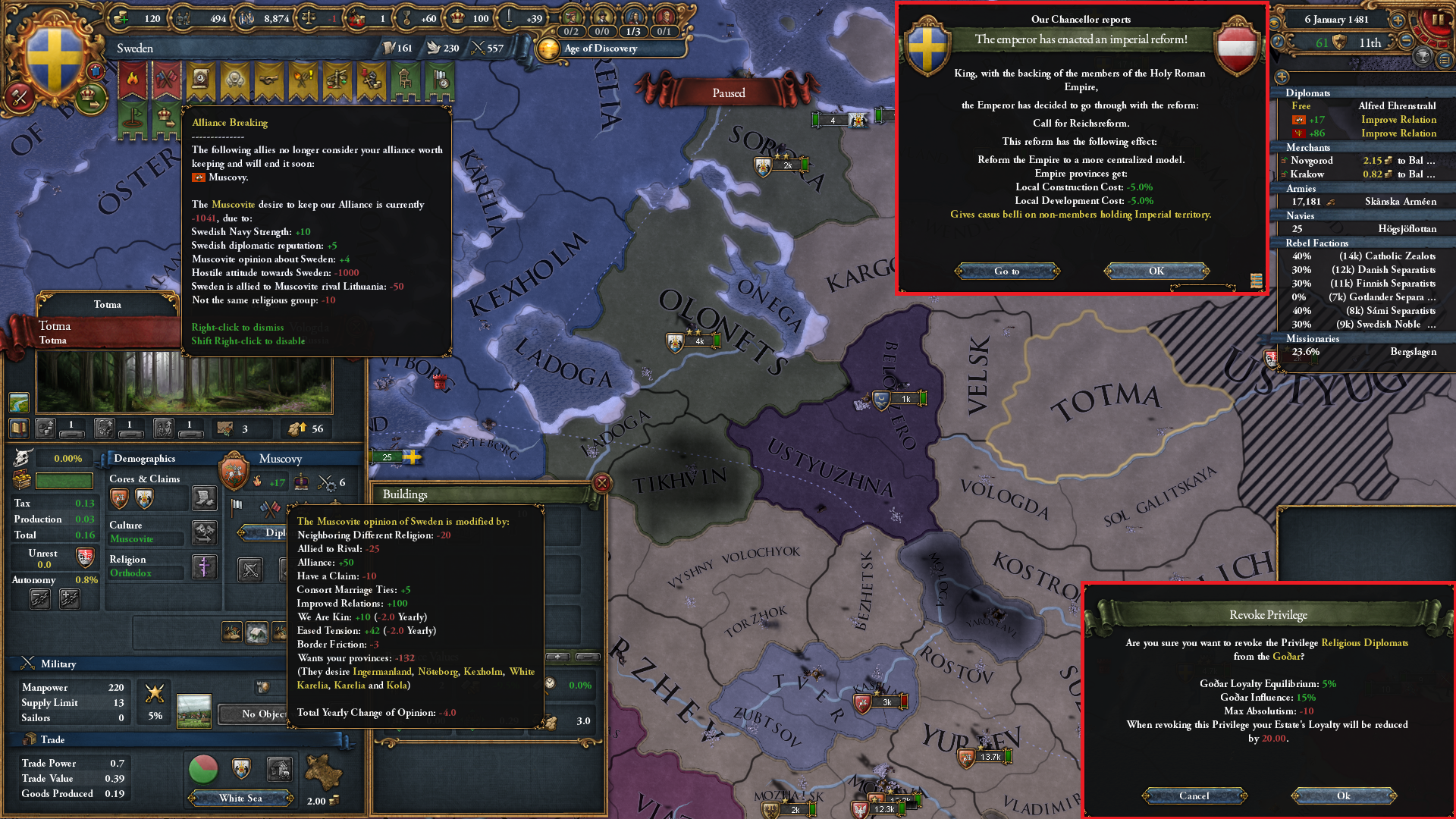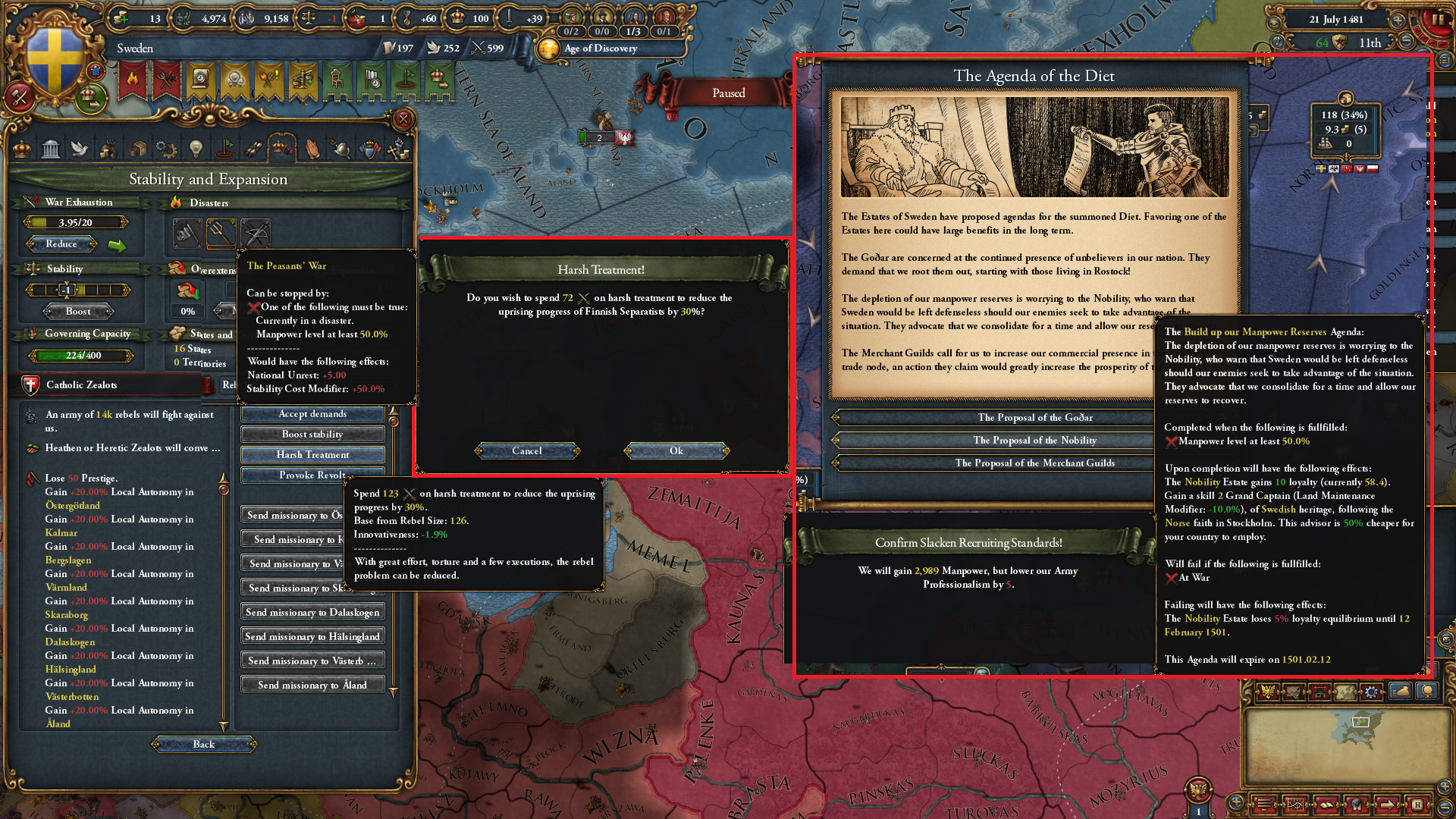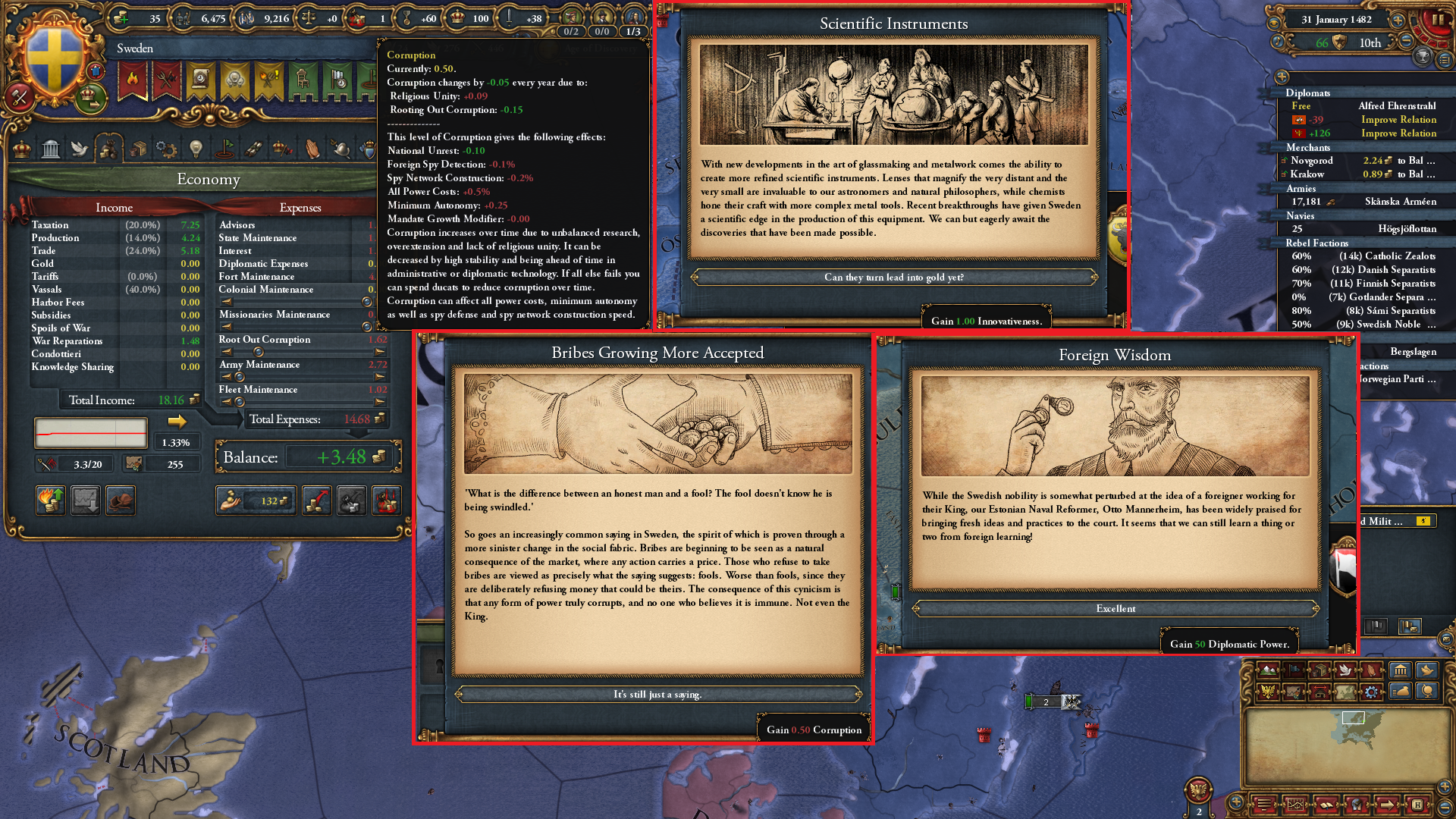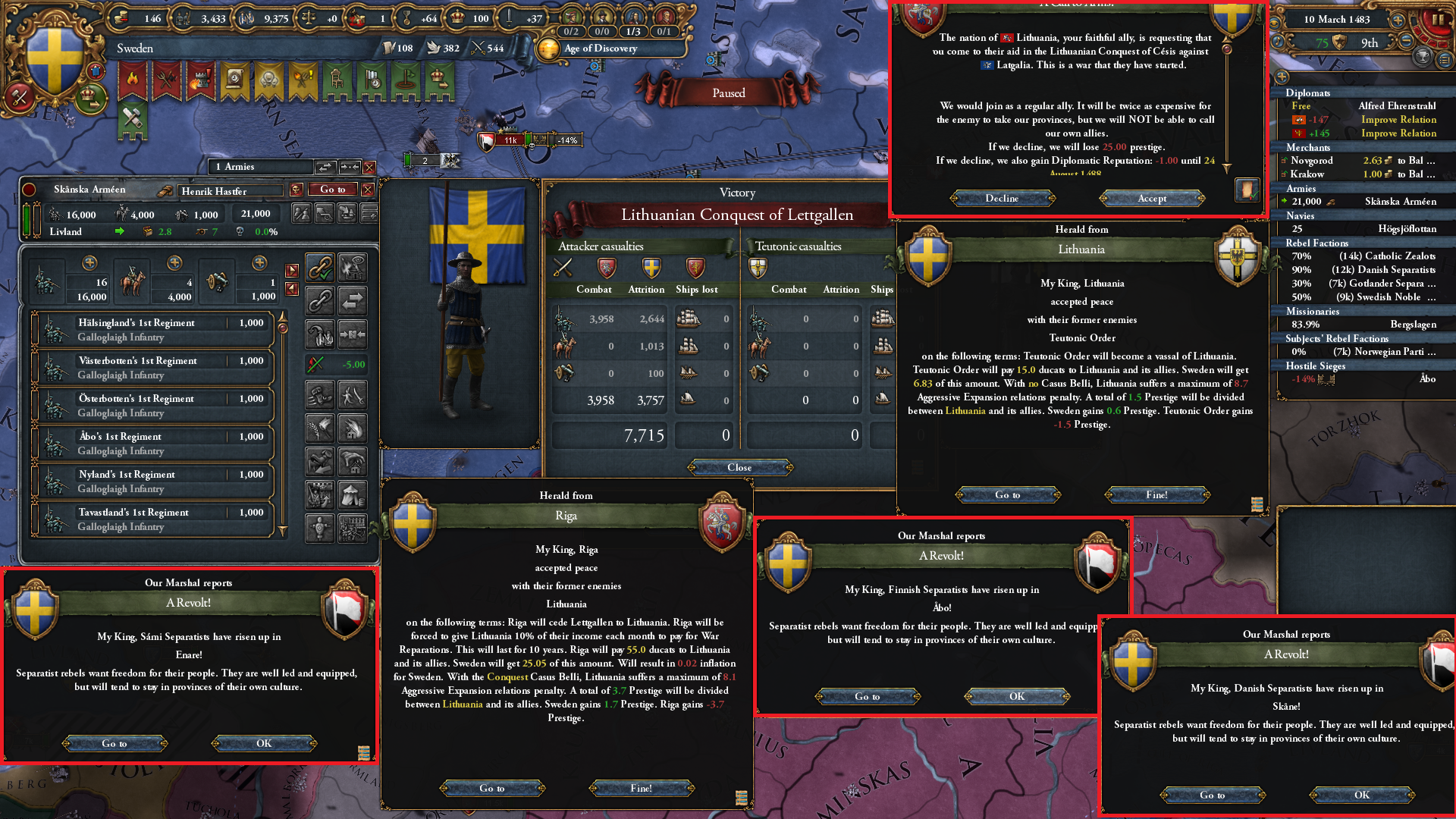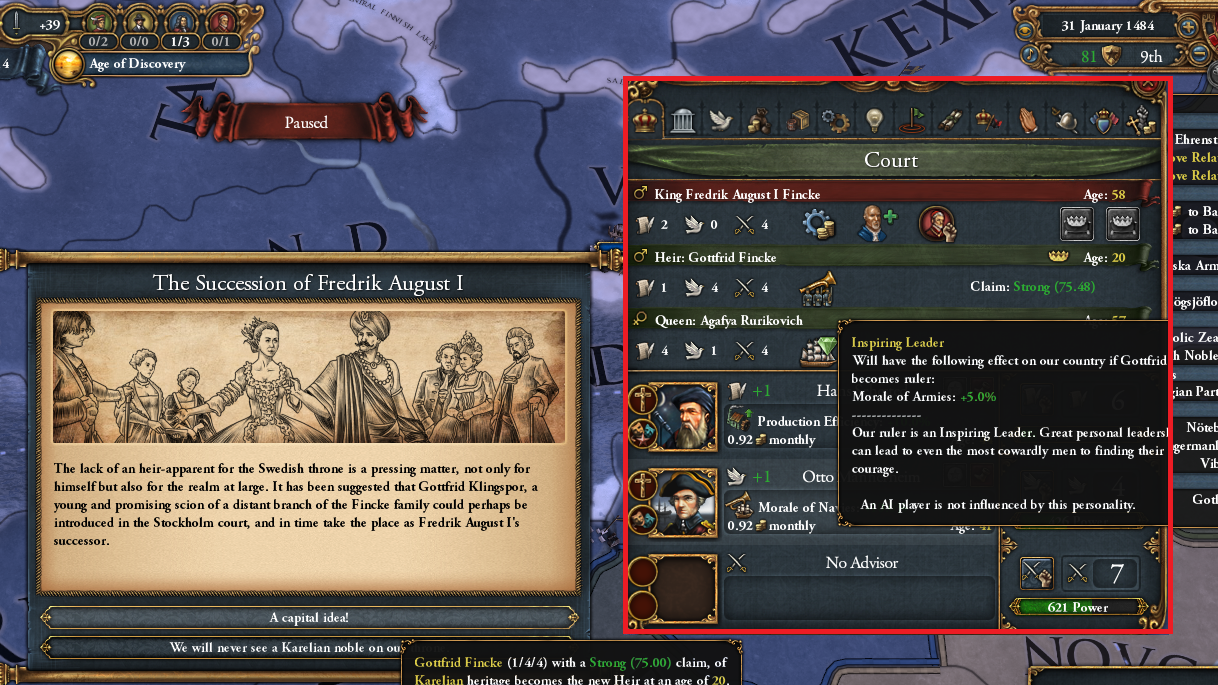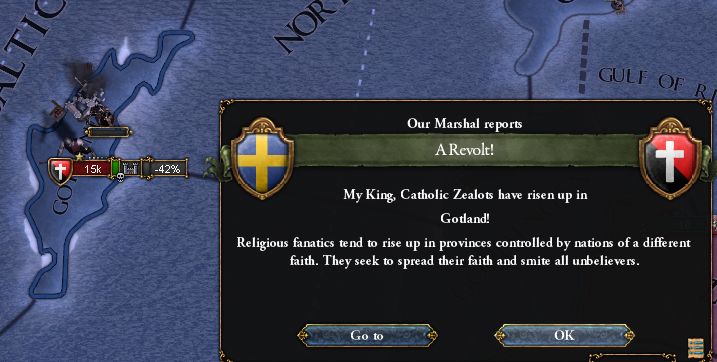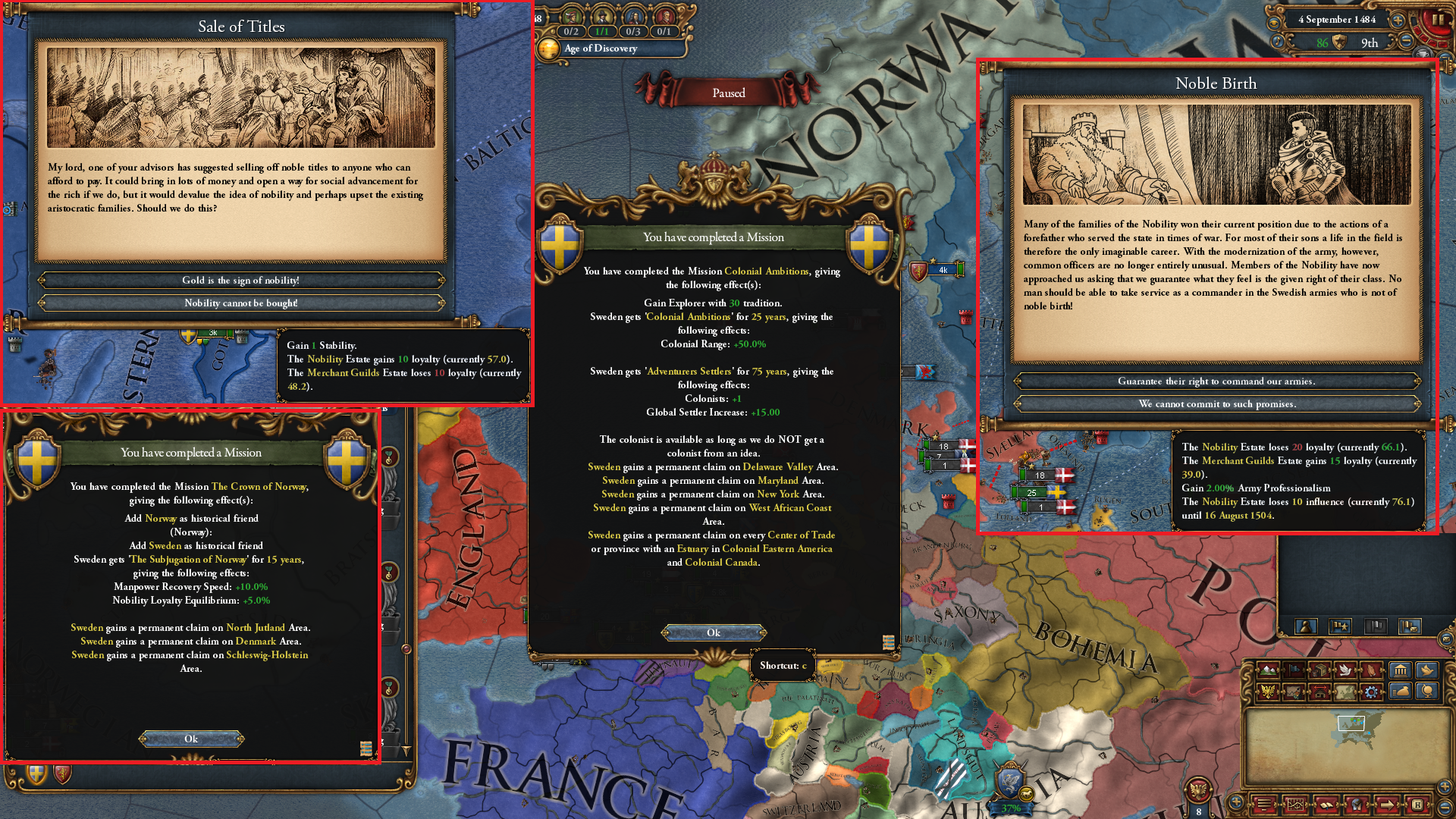Chapter 1- The Swedish Uprising (False start)
When I heard about the new Norse conversion events that came in with "Lions of the North", I (like many, I suspect) was intrigued. Specifically, the storyteller in me liked the idea of figuring out what something like that would actually look like, and it looks like nobody's done an AAR wit it yet, so I decided to make one. Not that due to the specific conditions required for the events, and their general unlikeliness, I won't be doing this playthrough on ironman, though I'll not reload except to get the events unless I judge that I've genuinely made a mistake.

Fig1- the internal divisions of the Kalmar Union.
However, while this was theoretically a union of equals, in practice King Christopher III was King of Denmark and the other realms were managed for Danish benefit. Many Swedes chafed under the rule of the smaller and less populous Danish realm. While there had long been talk of going their own way, it was not until 1444 that anyone seriously did anything about it. Discussions between Swedish nobles seeking independence and wealthy merchants fed up with the focus on German trade to the detriment of the Baltic formed a sort of cabal- which they called the Stockholm Thing, for they envisioned it as the locus of the government of an independent Sweden, and even managed to pull in the Archbishop of Uppsala with promises of representation on the Thing and control over diplomacy.

The Swedish Army, commanded by Swedish nobles mostly loyal to the Stockholm Thing and composed of their levy troops- was quietly expanded. Knowing that it would be vital to prevent the Danish and anyone who sought to intervene on their behalf from easily reaching the Swedish peninsula- for the House of Wittlesbach was originally German and was still deeply involved in the politics of the Holy Roman Empire - the Stockholm Thing began the mustering of a great fleet in the Gulf of Bothnia under the command of Gottfrid Alkmaar, where the Danes would hopefully not pay much attention. They also sent out feelers to the enemies of the Kalmar union. Burgundy, needing any ally in its precarious position, was eager to help. The English were also keen to aid, as they competed with the Kalmar Union for control of the North Sea and would benefit from a more eastward-facing Scandinavia. For this reason, Scotland also offered their help without even being asked. The Grand Duke of Lithuania was initially interested, but his inheritance of the Polish throne soon drew his attention to other matters.

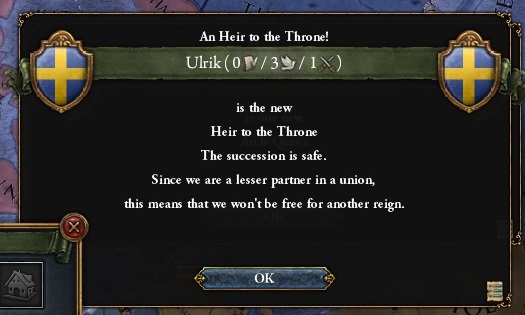
Two men ultimately emerged as leaders of the Stockholm Thing- Johan Vasa and Johan Gyllenstierna. Vasa was an obvious candidate for leadership- he was the most experienced battlefield commander and leader of the largest contingent of troops, and as such was given overall command of the army. Ulrik Piper was considered as overall commander, but ultimately relegated to a more logistical role. Gyllenstierna’s path to power was an odder one- he was very young and less of a man of action, but had a keen analytical mind, being educated and very interested in how things worked. He had for a while studied to become a priest, but had left after seeing the inner workings of the Catholic Church, then at the peak of its indulgence-selling corruption and become extremely cynical about religious affairs. Still, he could speak with great passion about the future glories of Sweden and recruited many into the Stockholm Thing. The question of who would actually be king was delayed until independence was secured, but realistically it would be one of those two.
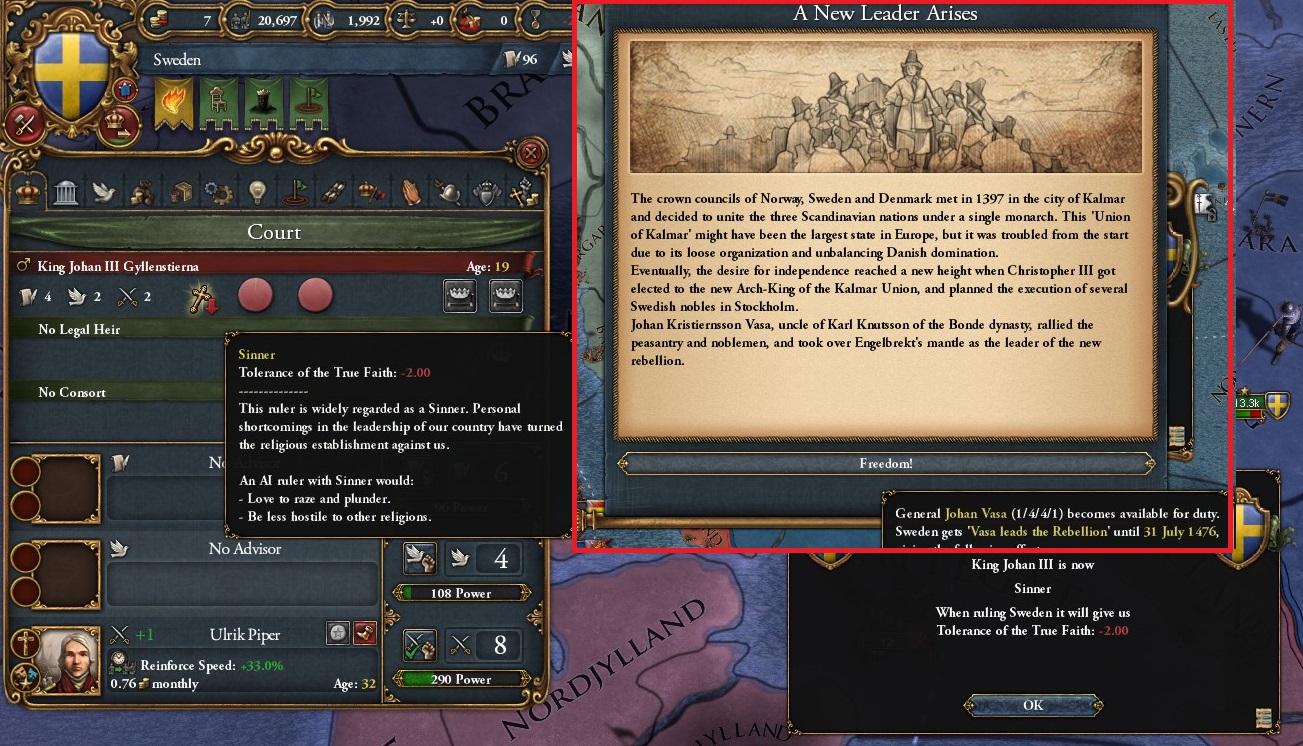
It was on November First, 1446 that the independent Kingdom of Sweden was officially proclaimed- Vasa hoped that the Danish armies would be reluctant to push north as winter approached, giving them time to regroup if things went wrong. The fortress of Elfsborg would be key to the entire battle- it was in Swedish land and blocked the key passage to Norway. As long as the Swedes held it, the Norwegian army could not contribute to the main battles in the south. The Danes knew this as well, so the first battle of the war was fought there, and Vasa’s army prevailed.

After seeing off the main Danish army, Vasa turned north to see off the Norwegians who had been coming to try and join up with them. Both ultimately ended up fleeing south to Scania, where Vasa continued his defeat-in-detail plan, pursuing whichever was in better order Ultimately, both fled north to Norway to regroup. The Bothnian fleet was also mobilized, and sailed south into the Oresund to prevent Brandenburg from ferrying troops over. With local superiority assured, the local capital of Lund soon surrendered

At the same time, Sweden’s British allies were making their presence known, with English troops landing in Jutland and Scots marching into Brandenburg. The small German city-state of Oldenburg, seeing the writing on the wall, promptly abandoned the war, paying an indemnity to Sweden in exchange for peace.
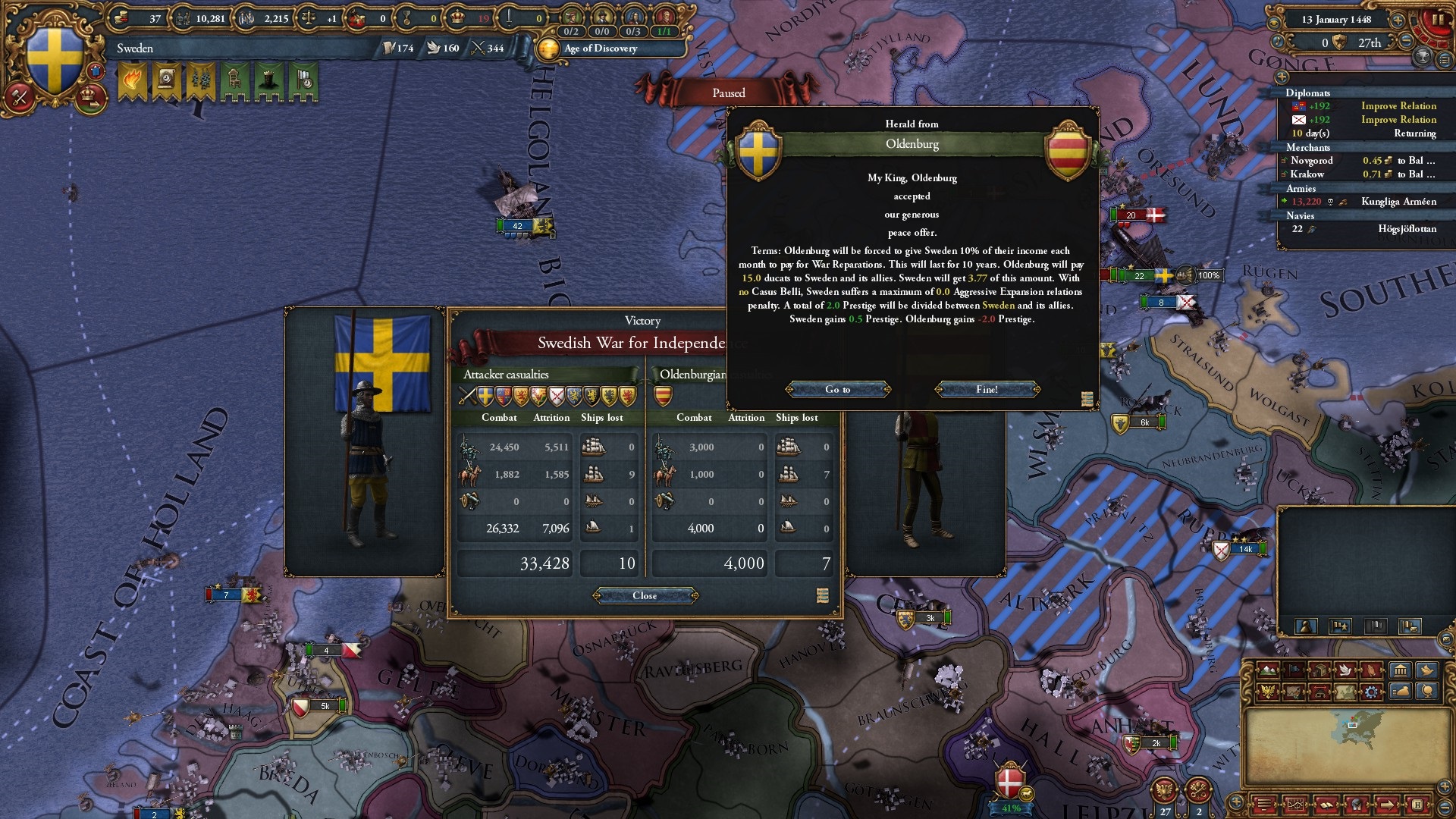
The only remaining problem was the main Danish army. Cut off behind enemy lines, they had not quailed, but rather pushed on to Stockholm, hoping to end the war by killing the claimants to the throne and the entire Thing. The city was put to siege, and the walls constantly attacked- the attackers could not be supplied from Denmark, so there was a real risk of them running out of food. But the defenders did not know this, or of Vasa’s victories in the south. For all they knew, this could be the last stand of the Swedish rebellion.
This was Johan Gyllenstierna’s moment. He made it his full-time job to coordinate the defenses of the city and maintain morale, often wielding a bow from the city walls. Though fighting was fierce, with accounts speaking of entire sections of the walls being controlled from siege towers, the Danish army was not able to enter the city in any real numbers. Soon, word reached Vasa of the desperate situation. He was forced to turn around and drive the enemy from the walls of Stockholm, but after one more battle at the gates, the outcome was decided. Sweden would be independent with its pre-Kalmar Union borders plus all of Scania- Denmark would no longer have a toehold on the peninsula. It was done. Sweden was free.
For the king of their new land, the Thing chose the man whose valor they had personally witnessed, and who had been dwelling with them and protecting them. Disappointed but unwilling to risk Sweden being destabilized from the very start, Johan Vasa returned to his home in Rydbo.

Chapter 1- The Swedish Uprising
In the year 1444, Scandinavian politics were in a precarious position. The entire region was theoretically part of the Union of Kalmar, comprising the three kingdoms of Norway, Sweden and Denmark, ruled by one king, but each having their own internal structure.
Fig1- the internal divisions of the Kalmar Union.
However, while this was theoretically a union of equals, in practice King Christopher III was King of Denmark and the other realms were managed for Danish benefit. Many Swedes chafed under the rule of the smaller and less populous Danish realm. While there had long been talk of going their own way, it was not until 1444 that anyone seriously did anything about it. Discussions between Swedish nobles seeking independence and wealthy merchants fed up with the focus on German trade to the detriment of the Baltic formed a sort of cabal- which they called the Stockholm Thing, for they envisioned it as the locus of the government of an independent Sweden, and even managed to pull in the Archbishop of Uppsala with promises of representation on the Thing and control over diplomacy.

Fig2- the initial composition and division of authority of the Stockholm Thing
The Swedish Army, commanded by Swedish nobles mostly loyal to the Stockholm Thing and composed of their levy troops- was quietly expanded. Knowing that it would be vital to prevent the Danish and anyone who sought to intervene on their behalf from easily reaching the Swedish peninsula- for the House of Wittlesbach was originally German and was still deeply involved in the politics of the Holy Roman Empire - the Stockholm Thing began the mustering of a great fleet in the Gulf of Bothnia under the command of Gottfrid Alkmaar, where the Danes would hopefully not pay much attention. They also sent out feelers to the enemies of the Kalmar union. Burgundy, needing any ally in its precarious position, was eager to help. The English were also keen to aid, as they competed with the Kalmar Union for control of the North Sea and would benefit from a more eastward-facing Scandinavia. For this reason, Scotland also offered their help without even being asked. The Grand Duke of Lithuania was initially interested, but his inheritance of the Polish throne soon drew his attention to other matters.

Fig3- the Bothnian fleet.

Fig4- King Christopher officially declaring his son Ulrik as heir to the entire Kalmar union lent greater urgency to the machinations of the Stockholm Thing
Two men ultimately emerged as leaders of the Stockholm Thing- Johan Vasa and Johan Gyllenstierna. Vasa was an obvious candidate for leadership- he was the most experienced battlefield commander and leader of the largest contingent of troops, and as such was given overall command of the army. Ulrik Piper was considered as overall commander, but ultimately relegated to a more logistical role. Gyllenstierna’s path to power was an odder one- he was very young and less of a man of action, but had a keen analytical mind, being educated and very interested in how things worked. He had for a while studied to become a priest, but had left after seeing the inner workings of the Catholic Church, then at the peak of its indulgence-selling corruption and become extremely cynical about religious affairs. Still, he could speak with great passion about the future glories of Sweden and recruited many into the Stockholm Thing. The question of who would actually be king was delayed until independence was secured, but realistically it would be one of those two.

Fig5- 17th- century painting of Johan Vasa, Johan Gyllenstierna, and Ulrik Piper
It was on November First, 1446 that the independent Kingdom of Sweden was officially proclaimed- Vasa hoped that the Danish armies would be reluctant to push north as winter approached, giving them time to regroup if things went wrong. The fortress of Elfsborg would be key to the entire battle- it was in Swedish land and blocked the key passage to Norway. As long as the Swedes held it, the Norwegian army could not contribute to the main battles in the south. The Danes knew this as well, so the first battle of the war was fought there, and Vasa’s army prevailed.

Fig 6- The First battle of Elfsborg
After seeing off the main Danish army, Vasa turned north to see off the Norwegians who had been coming to try and join up with them. Both ultimately ended up fleeing south to Scania, where Vasa continued his defeat-in-detail plan, pursuing whichever was in better order Ultimately, both fled north to Norway to regroup. The Bothnian fleet was also mobilized, and sailed south into the Oresund to prevent Brandenburg from ferrying troops over. With local superiority assured, the local capital of Lund soon surrendered

Fig. 7- Troop movements in the Scanian front
At the same time, Sweden’s British allies were making their presence known, with English troops landing in Jutland and Scots marching into Brandenburg. The small German city-state of Oldenburg, seeing the writing on the wall, promptly abandoned the war, paying an indemnity to Sweden in exchange for peace.

Fig. 8- Troop movements on the European mainland.
The only remaining problem was the main Danish army. Cut off behind enemy lines, they had not quailed, but rather pushed on to Stockholm, hoping to end the war by killing the claimants to the throne and the entire Thing. The city was put to siege, and the walls constantly attacked- the attackers could not be supplied from Denmark, so there was a real risk of them running out of food. But the defenders did not know this, or of Vasa’s victories in the south. For all they knew, this could be the last stand of the Swedish rebellion.
This was Johan Gyllenstierna’s moment. He made it his full-time job to coordinate the defenses of the city and maintain morale, often wielding a bow from the city walls. Though fighting was fierce, with accounts speaking of entire sections of the walls being controlled from siege towers, the Danish army was not able to enter the city in any real numbers. Soon, word reached Vasa of the desperate situation. He was forced to turn around and drive the enemy from the walls of Stockholm, but after one more battle at the gates, the outcome was decided. Sweden would be independent with its pre-Kalmar Union borders plus all of Scania- Denmark would no longer have a toehold on the peninsula. It was done. Sweden was free.
For the king of their new land, the Thing chose the man whose valor they had personally witnessed, and who had been dwelling with them and protecting them. Disappointed but unwilling to risk Sweden being destabilized from the very start, Johan Vasa returned to his home in Rydbo.

Fig. 9- 18th century painting of Christoper III of Denmary offering terms to Johan III of Sweden and the Swedish Allthing. The supplicant pose is probably ahistorical, but the mean building is not- a proper Thing-Hall had not yet been constructed
- 3
- 1


